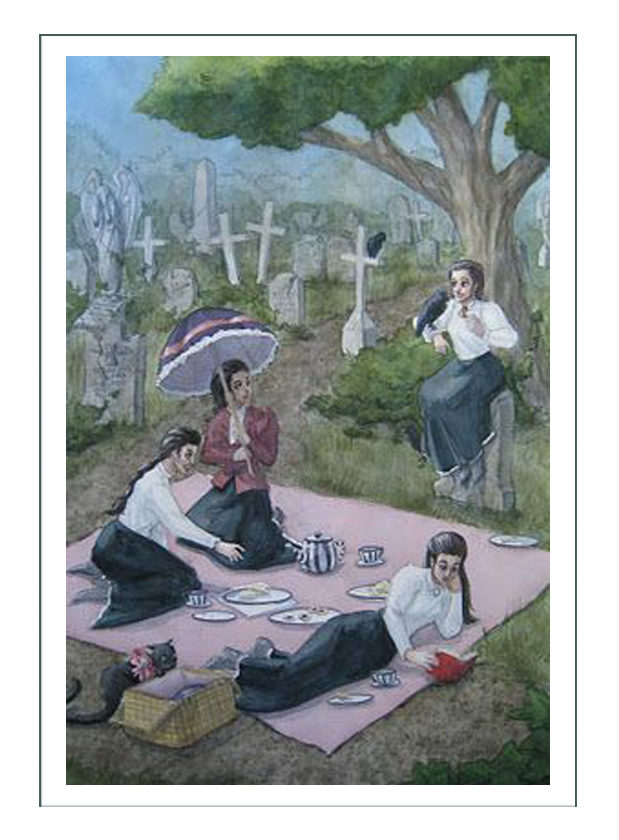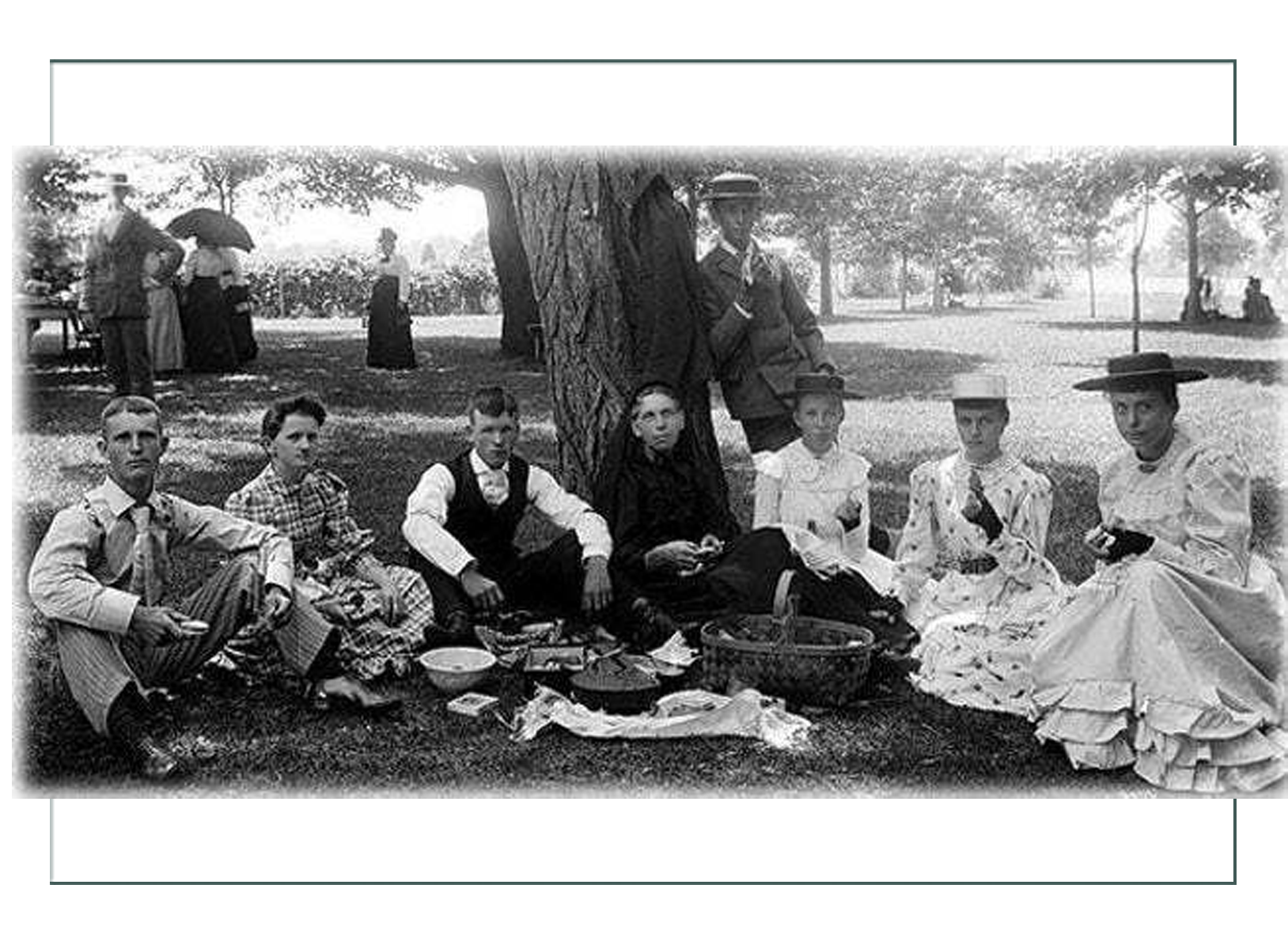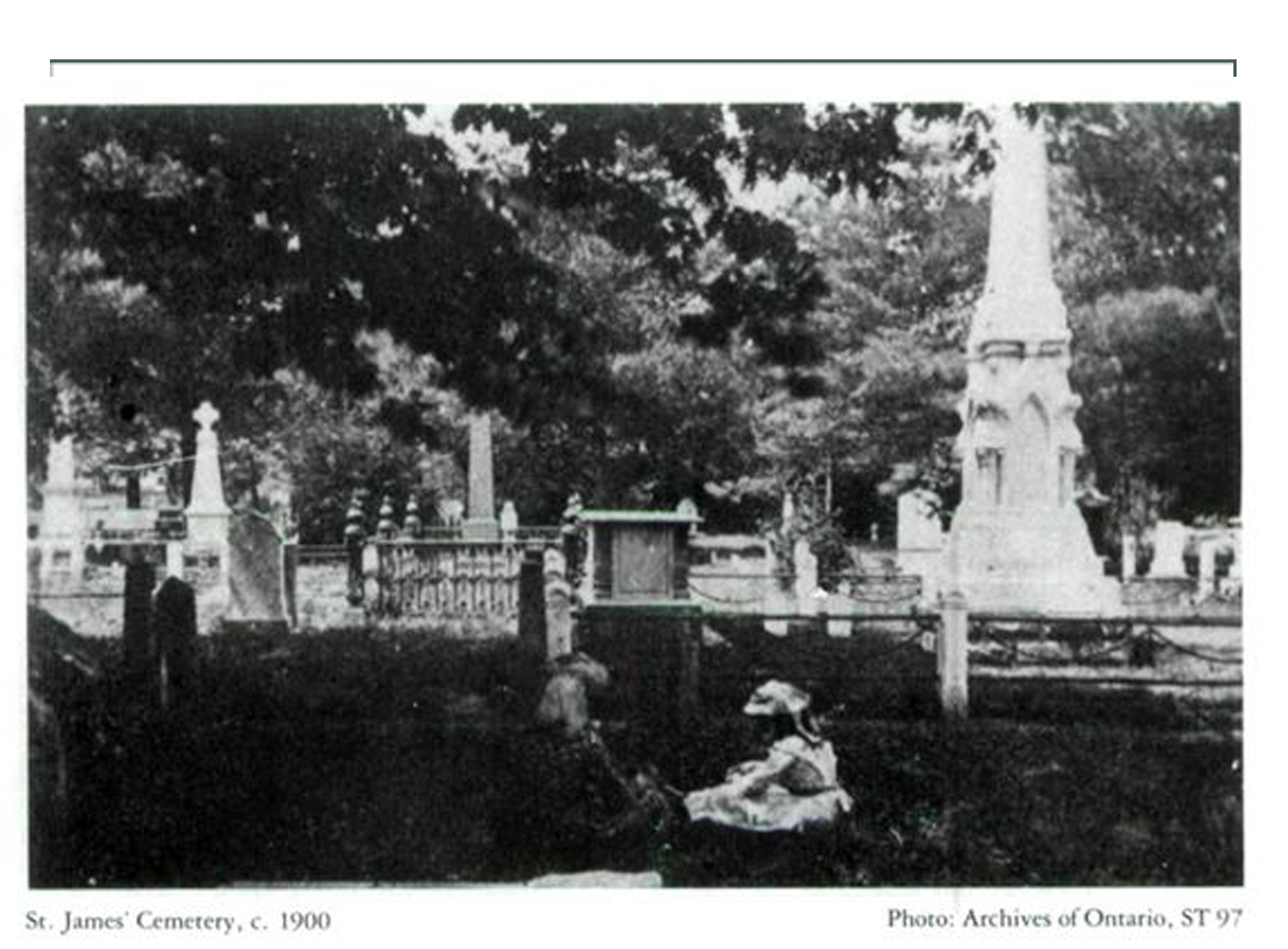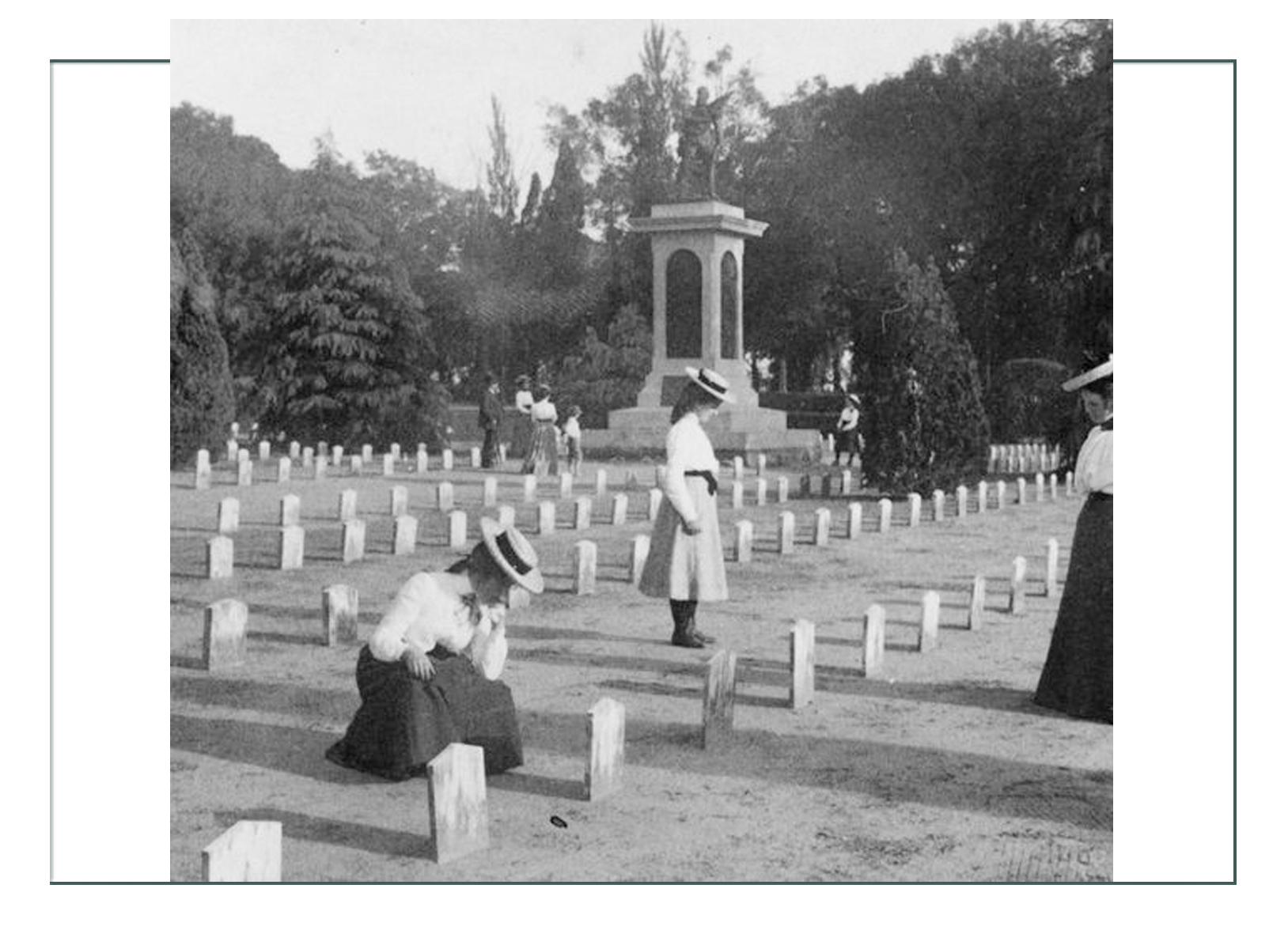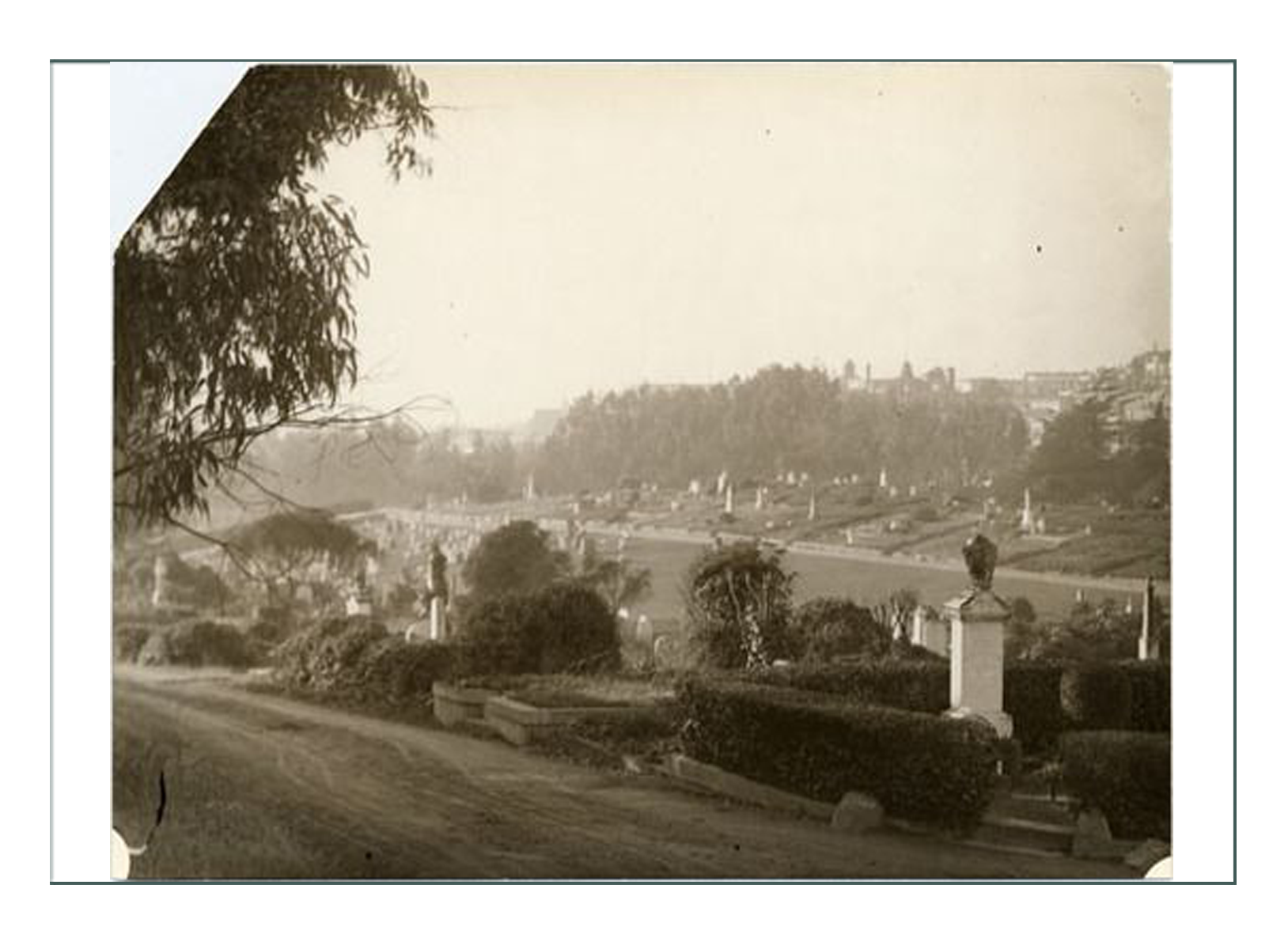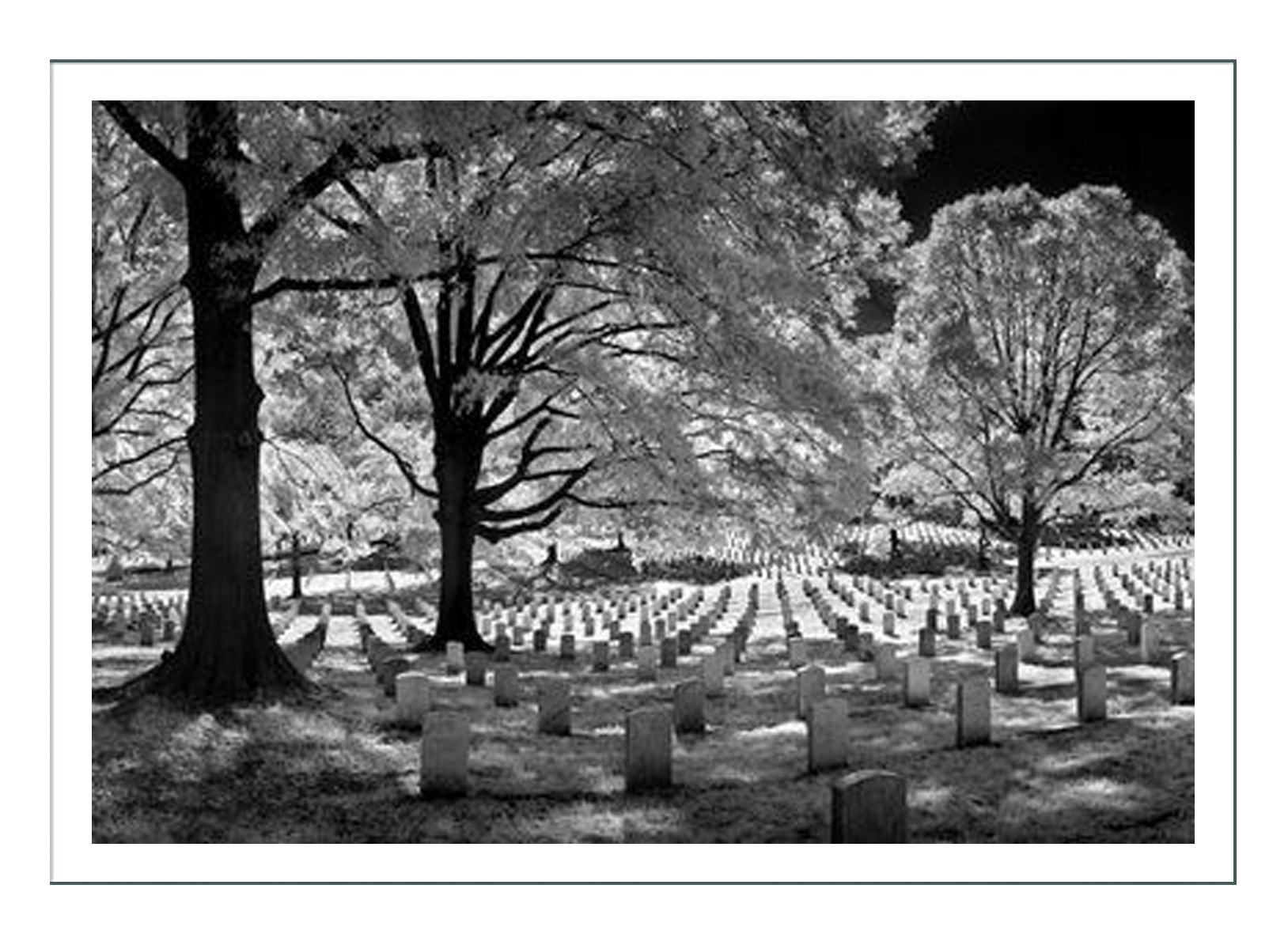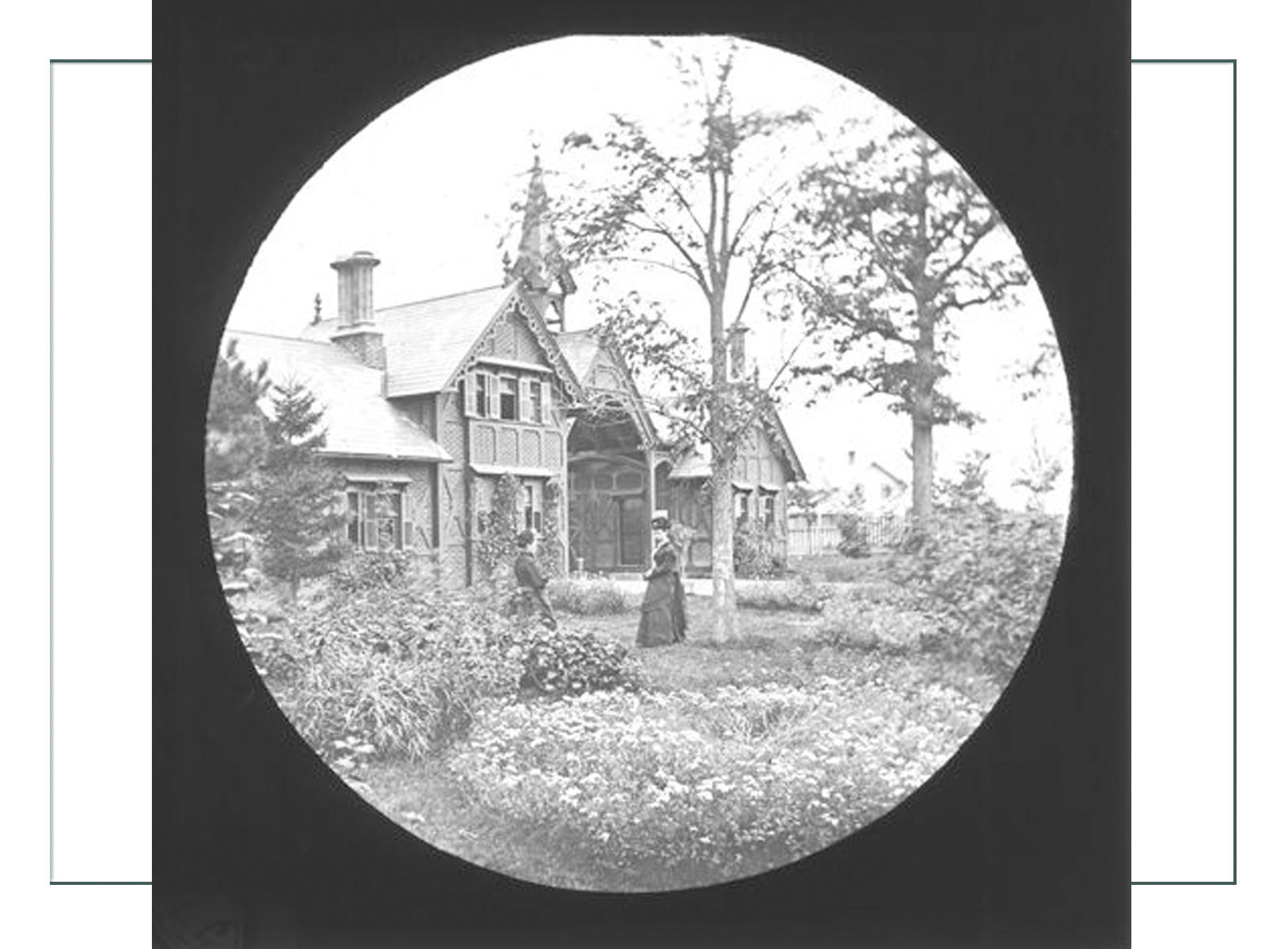
—— WORLD SITUATION ——
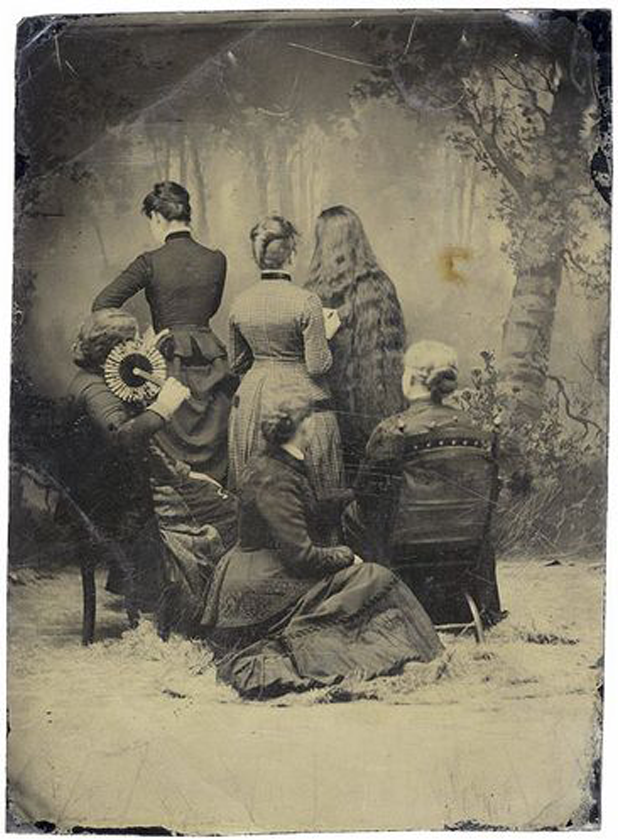
“The New Woman” was ordinary
- This era was leading up to World War I which would create major change to all social, political, & economical patterns worldwide
- After the war, it would be socially acceptable for women to work for themselves or to support families
- Despite prevailing nostalgic attitudes & efforts to slow progress, change was happening very quickly & very openly
- The Edwardian era seemed almost a last attempt at controlling women’s behavior & roles through regimens & rules, in a time they were otherwise escaping the Victorian edicts & making great strides towards independence
- Women were being recognized as thinking beings with more to offer than being a social asset for a husband
- By 1900 the railway, typewriter, telephone, post office, camera, sewing machine, rayon fibers, & bicycle made life for most women much easier, & allowed them the luxury of leisure or work pursuits
- For yet more women, the daily use of gas, water, electricity, & the motor car changed their lives significantly
- Since everyone – both men & women – had to figure out new inventions & how to use them, women achieved a status equal to men in many places
- Intellectual equality applied to women & men of all classes & status
- This dynamic of change for all persons changed the status of women overall
- Reform in political & social realms began as intellectual female thinkers began to outwardly state their case; e.g. many joined the Fabian Society, a group of non-revolutionary thinking socialists & similar groups
- Other women sought reform for more practical dress, better education, the right to have paid work if they wished, & better employment prospects for poorly paid women
- Most importantly, women campaigned for the right to vote & to obtain birth control, although most would not live to see those implemented
- During the WWI effort, women donated their corsets to yield 28,000 pounds of steel

In 1902, the “New Normal” for women was to get outside the home and the social dictate that the only successful woman was a wife and mother. They got out of the house for work or leisure, and their clothes had to keep up with them.
There was at the time an endless list of activities and pursuits that were now socially acceptable ranging from acrobats and weightlifters to dogtrainers and politicians. Women were in any number of sports, and many of them competing against men. The “New Woman” in particular was epitomized by Australian distance swimmer, vaudevillian, and film star Annette Kellerman who shocked Europe and America showing up on beaches in a nearly sheer “knit” swimsuit.
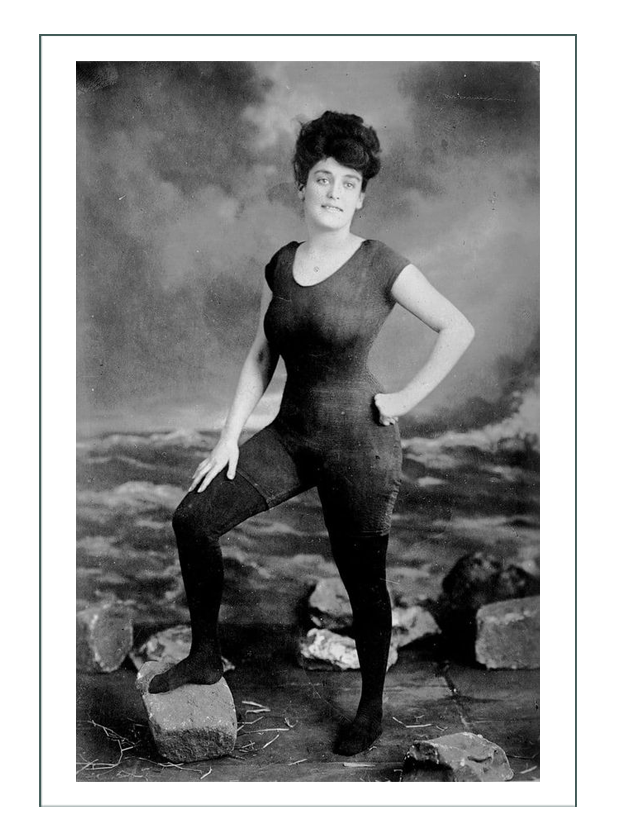
The “New Woman” was ordinary. Despite prevailing nostalgia of the “good old days” when women knew their place, the social change happened quickly and openly. Escaping Victorian edicts, the new Edwardians had a new set of rules under the leadership of the new king of England – Edward. Those rules meant not following rules.
Most American women by the turn of the century were interested in what the English were doing, but more for entertainment than leadership. They adapted lifestyle and fashion to suit their own needs (literally “suit”), taking what they liked and ignoring the rest. The pioneering spirit of innovation, technology, and independence had finally taken root in American women, and they were allowed to implement their ideas.
Women at last were recognized as thinking beings who could offer more than being a social asset to a husband. Women outwardly stated their cases and causes, and organized or joined societies that supported their beliefs and desires. Reform in the political world was of particular focus, as was the renewed energy put into the suffrage cause.
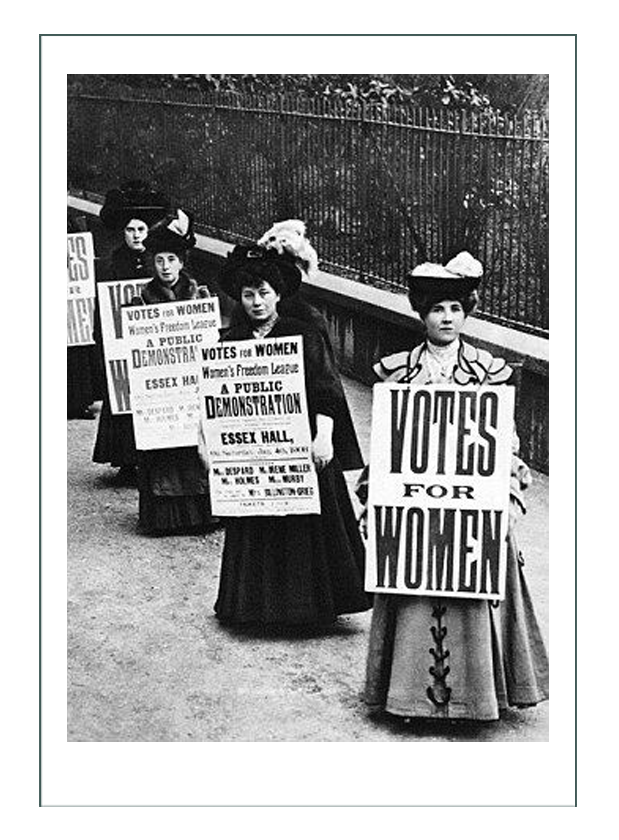
Many worked in reform for Indians, prisons, orphans, and other worthy causes. Others sought change in the political systems regarding dress, education, employment rights, birth control, and the vote. The Fabian Society and other intellectual groups were wildly popular throughout the U.S.
Innovations and technology, notably railway transportation, they typewriter, development of the post office, camera, further evolution of the sewing machine, rayon fibers, the bicycle, gas, water, and electricity in particular made positive and drastic change in the lives of women in particular. These things gave them jobs, a way to get there, and the ability to do work – on their own.
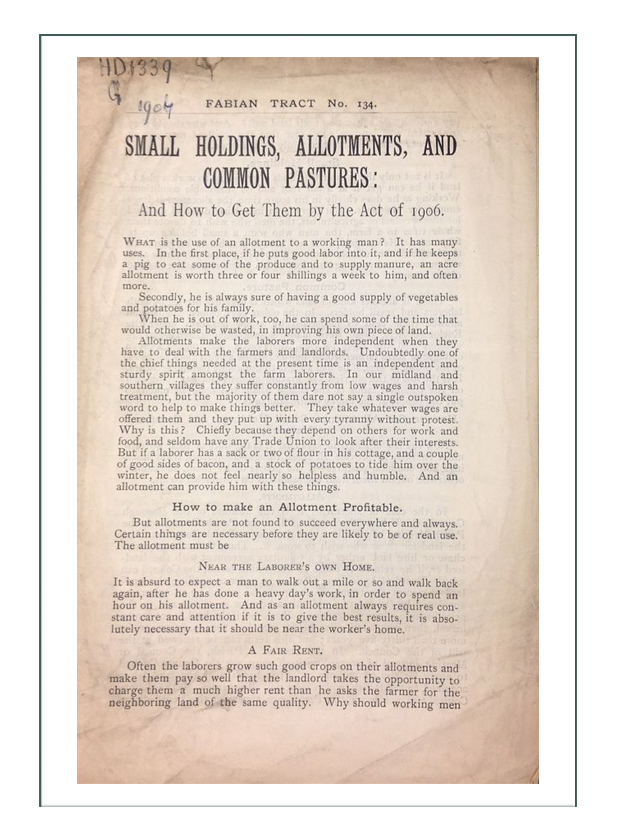
Every day women worked as governesses, shop assistants, and typists. Those with advanced education became teachers, secretaries, and office assistants. College and higher education was now considered acceptable for unmarried women, and some universities were starting to integrate men with women in America.
The clothing industry was the biggest employer after domestics (maids and servants). Mass production was flourishing. In hard times, a woman could do sewing in her home with the new machines. Millinery and headwear were doing a “roaring trade” thanks to fashion trends with huge hats and many accessories. Milliners also made the gloves, muffs, and details that marked Edwardian fashion, although the business of corsets reverted back again to men only.
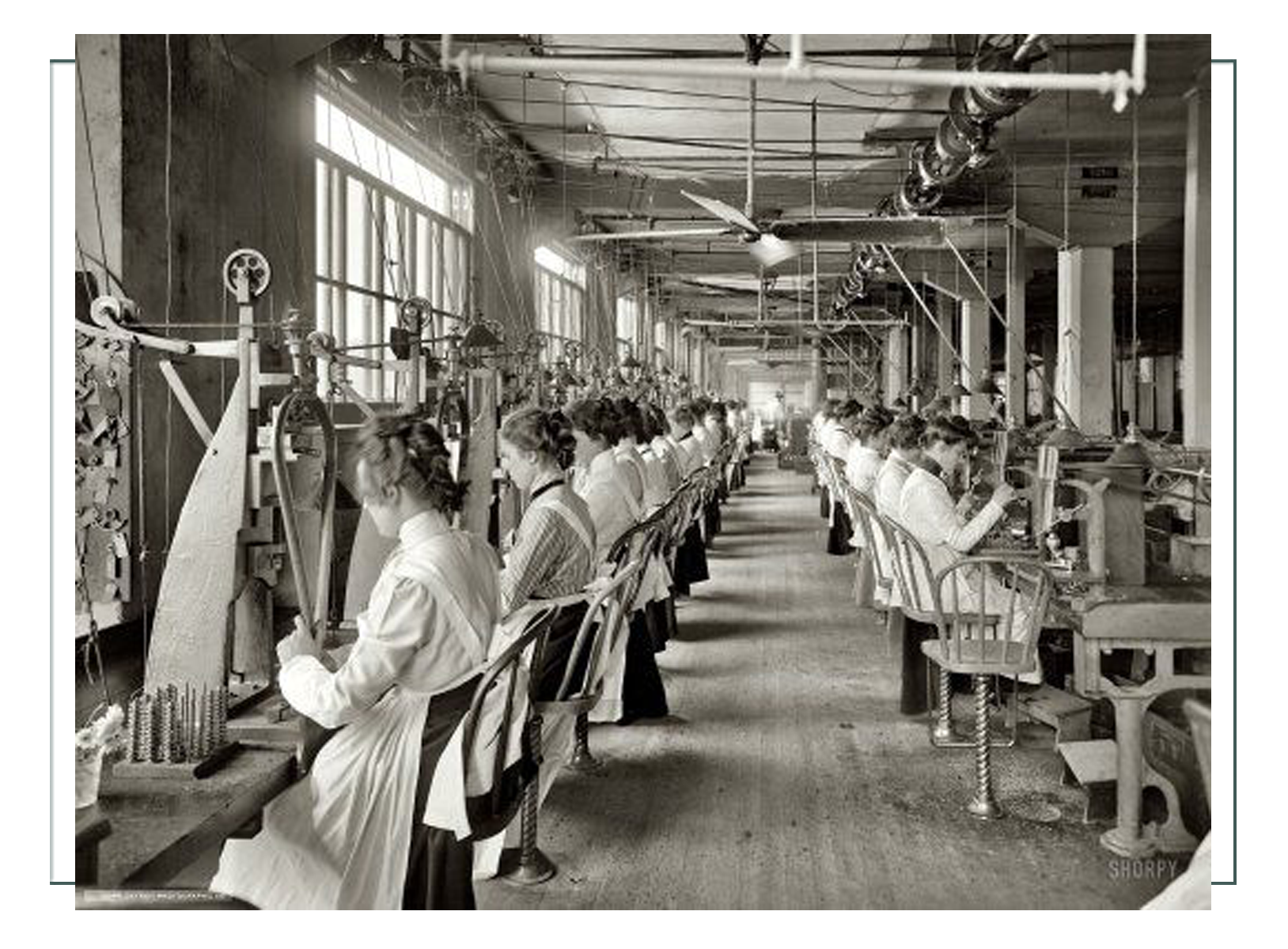
Young women were leaving the family farm, getting on the train, and heading for the cities to seek their fortunes. While creating a shortage of farm hands since girls did all the farm work plus housework, it led to entire social and cultural structures in urban situations with many single women living in one place.
Women were mixing with men in the workforce, although in subservient roles, but many were heading to college to become doctors, lawyers, and professionals on even status with the men. Class and gender lines were blurred the further one traveled West in 1902, as in the “Equality State” of Wyoming, women had already been leading businesses and taking leadership roles in politics. They had been voting for over 30 years already, so the issues were different for them. Their options for professional development were as wide open as the high plains of the West.
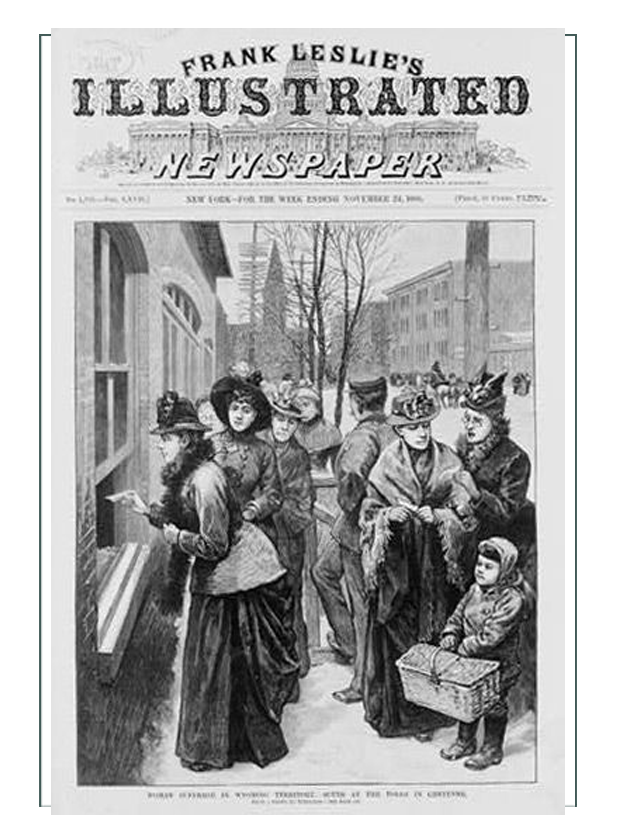

PLACES & ATTITUDES
This depiction being 1902-03, transitions between the Late Victorian and Early Edwardian eras. It was a time of very diverse and changing roles, attitudes, and positions for women.
- It was the transition between the Victorian era of restraint, & the loose fanciful life of the Edwardian
- The Victorian era had spanned 64 years, & changes in attitude were constantly shifting during that time
- Roles of women & women’s independence had somewhat paralleled the life of Queen Victoria herself who was crowned at age 18, & grew up during her reign
- The Edwardian era was named for Edward VII King of England who loved extravagant pleasures with balls, house parties, travel, athletics, & mobility
- Edwardian was defined by the laces, frills, & fluff of a FEELING
- In a fast-paced world of technological change, Edwardians tried to recapture a romantic & nostalgic past
- The era focused on a leisure class with leisurely pursuits
- Cars, races, & the drive towards women suffrage marked the time
- There was tea on the terrace alongside garden parties, regattas, & bountiful picnics
- Social & political structure was built on a rising middle class due to the industrial revolution
- The middle class “aped” the upper class
- Middle & upper classes had outfits specific to every occasion & activity
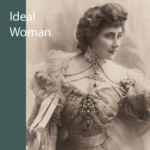
ROLES
- The attitude of men in the period was highlighted by the author Tennyson who wrote of “women staying by the hearth with their needles whilst men wielded their swords”
- By the end of Queen Victoria’s reign there were great differences apparent between classes, & this could easily be seen by the garments they wore
- The Victorian head of household dressed his women specifically to show off wealth
- A wealthy woman’s day was governed by rules of etiquette requiring up to 6 wardrobe changes a day, & 3 seasons of change
- Fashion plates were keys to give visual clues about how to dress for status
- For the very poor of Britain things were quite different. For them, 5th hand clothes were typical, as the average poor mill worker could only afford the food left over from a rich household, & survived on inferior meats, tainted breads, porridge, cheese, herring, or kippers
- The most acceptable career for all women was still marriage
- For the upper classes & rising middle class, to prepare for courtship, the typical girl was groomed like a racehorse
- She was required to sing, play an instrument, speak French or Italian, & to be innocent, virtuous, biddable, dutiful, & ignorant of intellectual opinion
- Women were expected to remain within marriage or outside of it as weak & helpless as a delicate flower incapable of making decisions beyond selecting the menu & ensuring her children were taught moral values
- A gentlewoman ensured the home was a place of comfort for her husband & family, away from the stresses of an industrial world
- An Edwardian woman’s prime use was to bear a large family & maintain a smooth family atmosphere so a man need not bother with domestic matters. He assumed the house would run smoothly so he could spend his focus on making money
- A wealthy wife was supposed to spend her time reading, sewing, receiving guests, going visiting, letter writing, seeing to servants, & dress the part of her husband’s social representative
- Even in high society, men kept mistresses, yet their wives were expected to be faithful no matter what
- If a woman took a lover, it was not made public, or she would be cut out of society
- Men could have a mistress & be warmly welcomed everywhere
- It was a hypocritical period when relationships were artificial until 1887 when the Married Woman’s Property Act gave women the right to own property
- Before the Act, anything a woman owned became her husband’s at their marriage, including herself
- If a wife separated from her husband, she had no rights of access to see her children, & no chance of acceptance in society ever again
- The Act changed all of that
- Fashion history usually depicts the style of those with wealth, & who met these cultural standards, showing typical excessive elements such as tiny V waists, layering of trims, & gigantic sleeves
- As the 1880’s progressed, dress became more & more lavish until clothing was nearly buried by lace & beading at the turn of the century
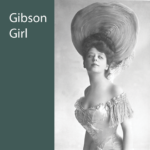
YET ANOTHER IDEAL WOMAN EMERGES
- The Gibson Girl the new ideal woman. While models were found to depict her, she never really existed
- This imaginary woman had large bosoms & hips, snub nose, small mouth, & upswept full hair
- The Gibson Girl was almost a merge of the extremes of the bustle era with all its draping, folds, & fuss, the Edwardian concept of the “Grand Dame” with her lace & tea, & the smooth lines of the natural forms & frizzy hair of “Aesthetic dress”
- The Gibson Girl image of the 1890’s combined elements of older images of caucasian female beauty: the “fragile lady” with slender lines & a sense of respectability & the “voluptuous woman” with large bust & hips who was never vulgar or lewd
- She was refined in beauty, spirit, & was calm, independent, confident, & sought personal fulfillment
- Portrayed at ease & always stylish
- She was often depicted attending college & vying for a good mate
- She would NEVER participate in the suffrage movement
- A member of upper class society
- More athletic-shaped; she was often depicted cycling in Central Park
- She exercised & was emancipated to the extent she could enter the workplace
- She had an exaggerated “S” curve torso achieved by wearing a swan bill corset
- The Gibson Girl Preoccupation with youthful features & ephemeral beauty
- She had a thin neck & her hair was piled high on her head in bouffant, pompadour, or chignon “waterfall of curls”
- The new image would be rehashed in each generation, eventually evolving into the “girl next door”, a national standard of wholesome beauty by standards of the ideal femininity of the time
- Of course, the Gibson Girl was invented by a man
- He created her based on his sister, & marketed the idea very successfully throughout the world
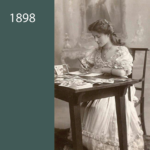
SCIENCE IN FASHION
- Scientific study of the human body called “anthropumetrics” had changed the design of drafted patterns so they could be standardized
- Women could now successfully sew garments in the home
- Catalog & department stores could make multiples in sizes for true “off the rack” or “ready made”
- Growing urbanization & rapid growth of technology included improvements in city living conditions
- Designers, builders, & manufacturers used “proportionate systems of measure” which applied to the fashion industry too
- In 1884 Dr. Jaeger, a German professor of Zoology in Germany, developed scientific theories about the hygiene of dress, & recommended the wearing of only wool next to the body
- Dr. Jaeger promoted the use of natural fibers in everything in the household to “prevent retention of noxious exhalations of the body”
- Science at the time was equated with being modern, & therefore regardless of Dr. Jaegers lack of scientific data, his research became the foundation for “dress reform”
- This led to many wool garments being produced in a range of colors

 Late Victorians in England & America
Late Victorians in England & America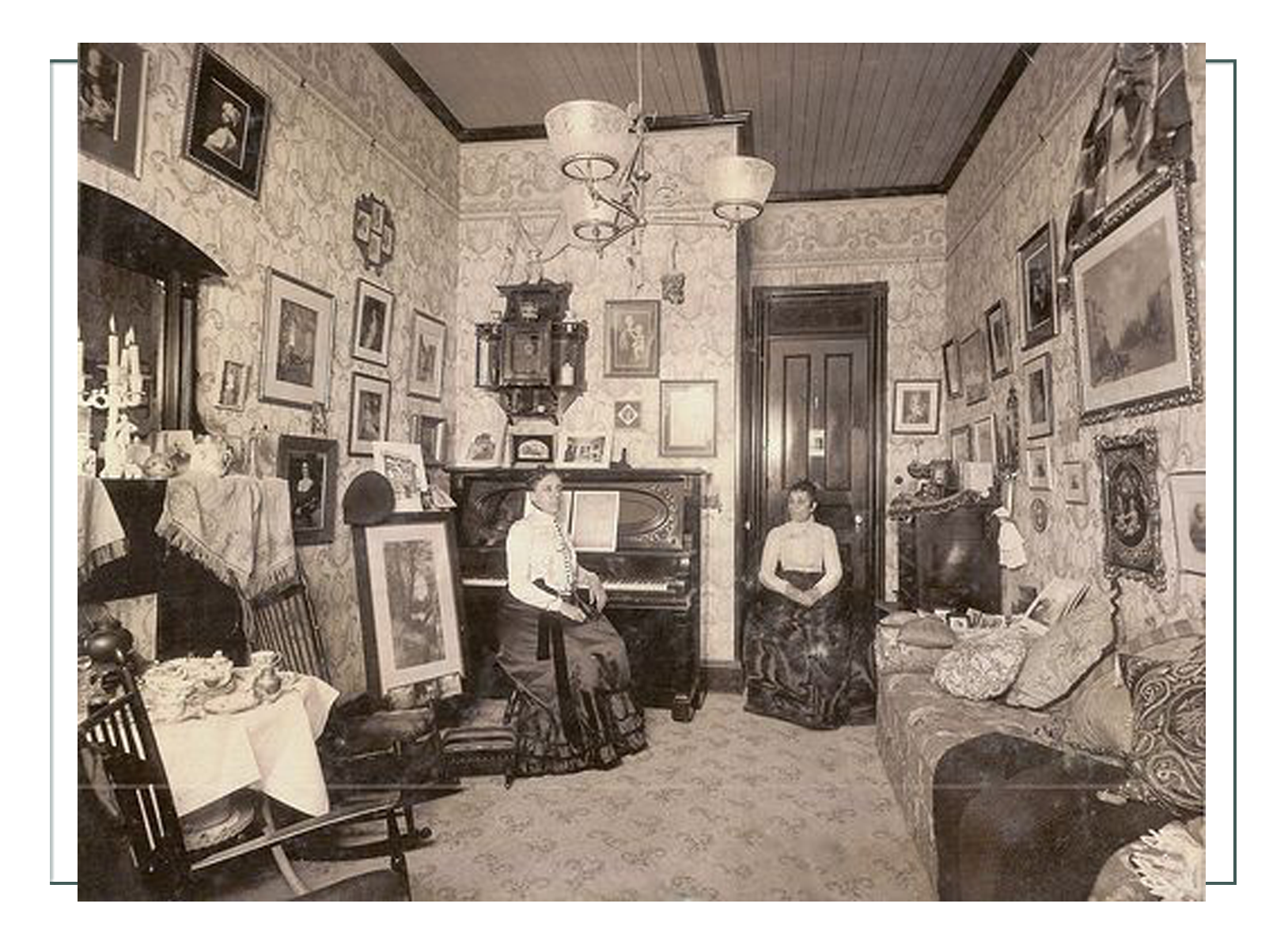
Victorian prosperity meant… ….Country became Urban. English elite prospered in the reign of Victoria due to development of new machinery, improved work methods, and an underpaid workforce that consisted of adults and children who lived in poverty.
The train in Victoria’s early reign took British to the cities… Many people previously rural became urbanized because they could take the train to town. Country families moved into crowded conditions in towns and cities to stay with relatives while they looked for work. Due to the huge population boom, many lived in poverty without water, sanitation, and sometimes food.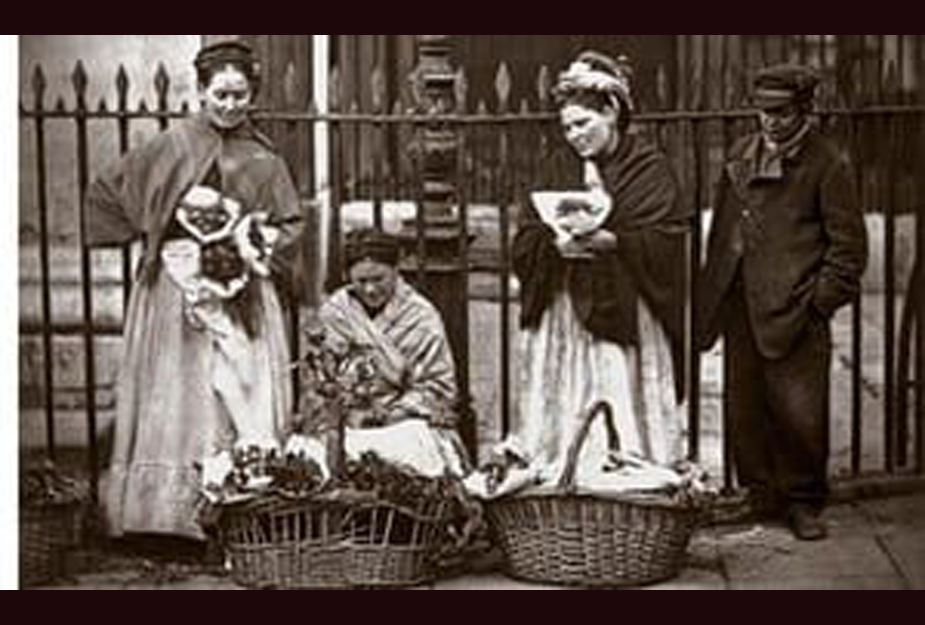
Poor women of 1850’s London receive baskets of food from the Queen
As a result of British society changing, Class structure… …dictated the rules of fashion. Each activity had appropriate apparel for those who could afford it. Those who couldn’t emulated the wealthy with simpler, less structured, and less costly versions of the elite. There was a HUGE industry of clothing resale with peddler carts in special districts for clothing for the working and lower classes.
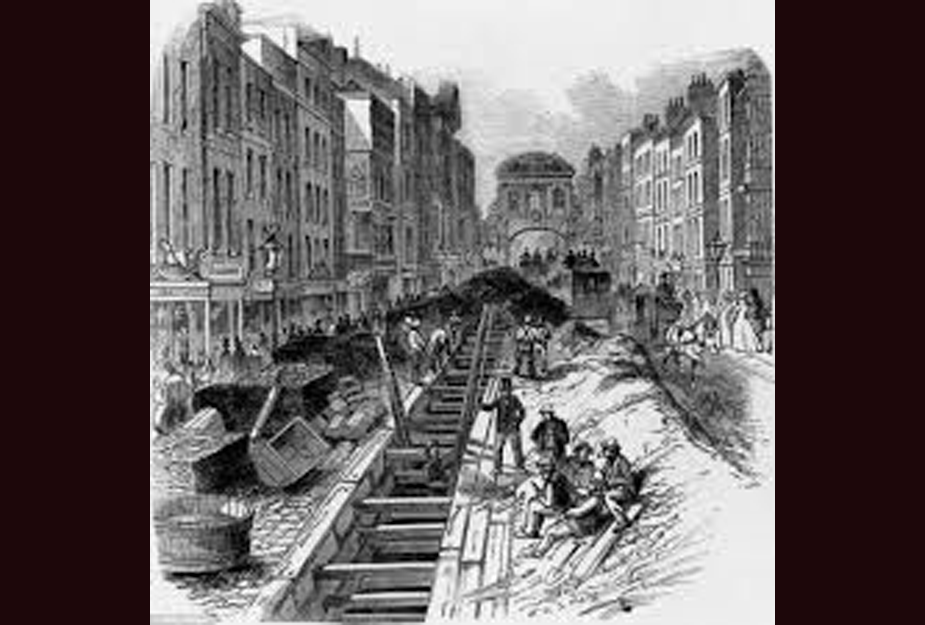
London’s tunnels like this under Fleet Street in 1840 were built in the early Victorian era
Places like Almack’s and White’s in London… … were highly valued organizations that nobles and elites of London aimed to access. Exclusive “clubs” by invitation only, the London “Seasons” were designed to meet and greet those of similar class status. For men at least, places like White’s were for socializing with entertainment and leisure away from the women.
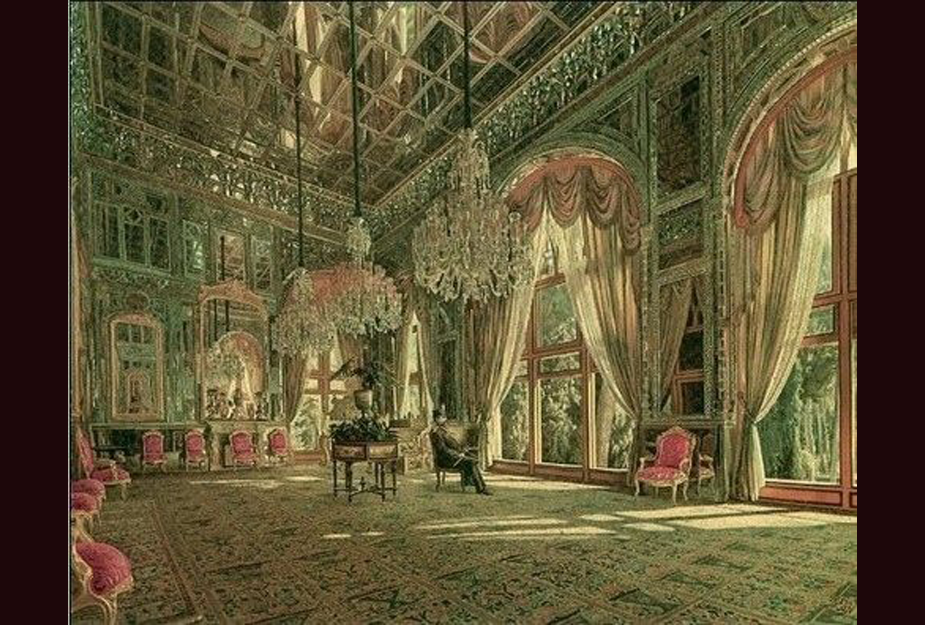
Almack’s for balls; below White’s for men to gamble, drink, and be ‘manly’
Fashion of the elite was very specifically defined. Queen Victoria of England hosted events… .. like balls – small and large scale for entertainment for royals and elites. Her dictates on clothing were EXACT.
Britain’s population became urbanized… .. and by 1850, under Queen Victoria, half the country had moved to the cities. Industrial growth and the resulting building boom, and the spread of the railroad combined with a population boom had the character of Britain suddenly changing.
Small towns were overtaken by giant industries. Towns like Crewe which were already on the railroads became “hubs”. “Hubs” met each other to become large joined towns. By 1870, Britain had grown from 10 million people to 26 million.
Factors of population growth, change in occupation, change in location meant change in culture and economy which would mean – change in fashion.
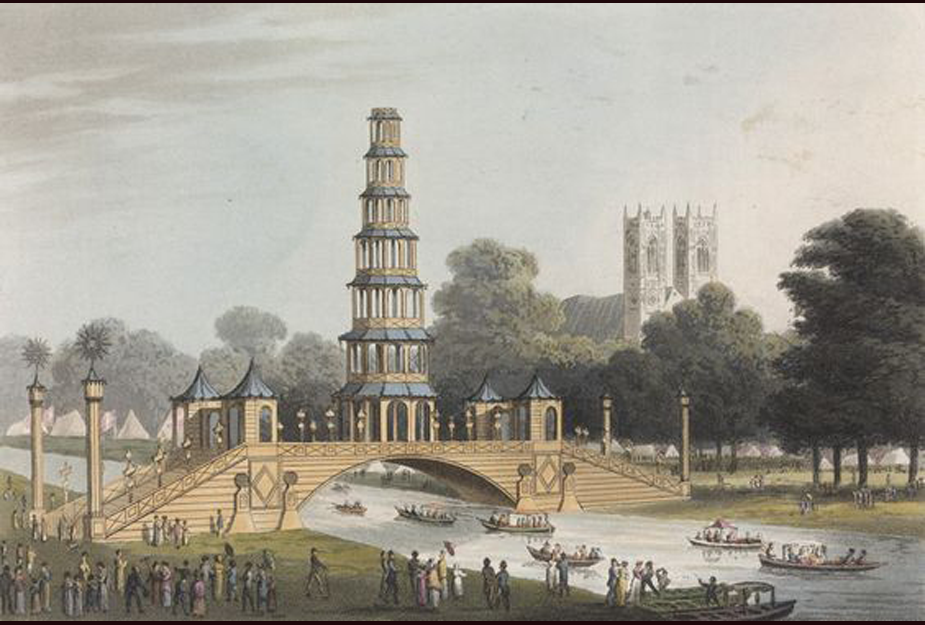
St. James Park, London before industrialization
New Social Classes emerged in Victoria’s Britain… Improved transportation and the ability to get around meant the English could seek jobs that were not available to them before. While many lived in poverty, others rose in status as the previously defined class structure changed.
Employers moved away from their industrial source of wealth. They bought country estates and were often considered landed gentry. Men without noble ties, previously considered lowly, now rose in status on the basis of their wealth. Some built new streets of houses at the edge of town for their skilled workmen and artisans to live in.
Their key employees and managers built villas outside of town too.
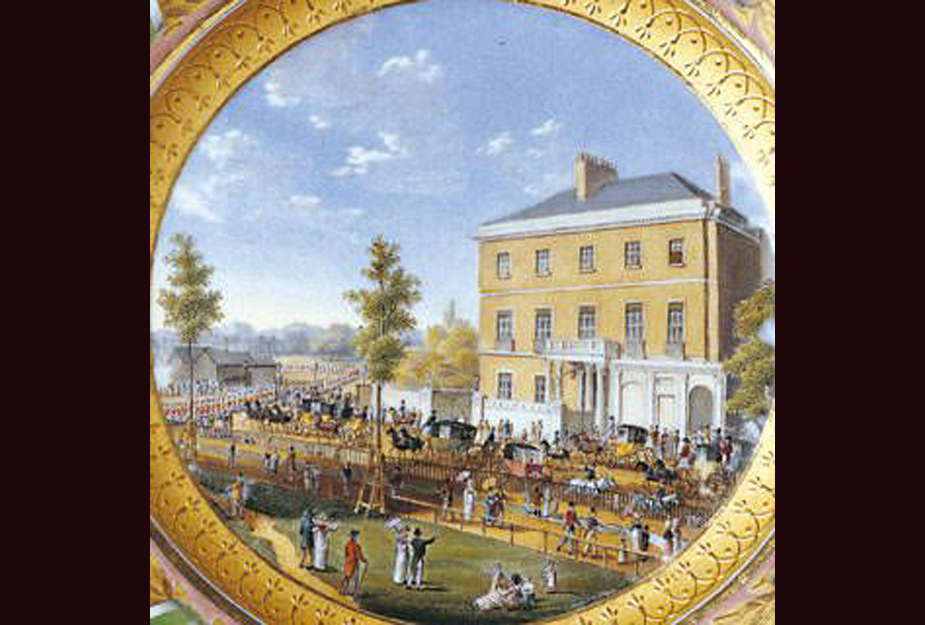
Apsley house, the home of the Duke of Wellington as it looked in 1816. Villas and homes like this were no longer reserved for titled gentlemen like the Duke by the 1850’s in Britain
British class divisions were still apparent… ..in places like church where the higher classes sat in reserved pews, and on trains where they had luxurious cars. Lower classes remained lower classes, but the rising bourgeoisie middle class had an outward display of wealth through clothing and possessions that allowed them to mix in with the high society that was formerly reserved for blooded and titled nobles only.
British wives of industrialists and business owners, dressed in finery “fit for a queen” as they were their husband’s business marketing representatives. It became difficult to distinguish these women from nobility based on how they dressed or behaved.
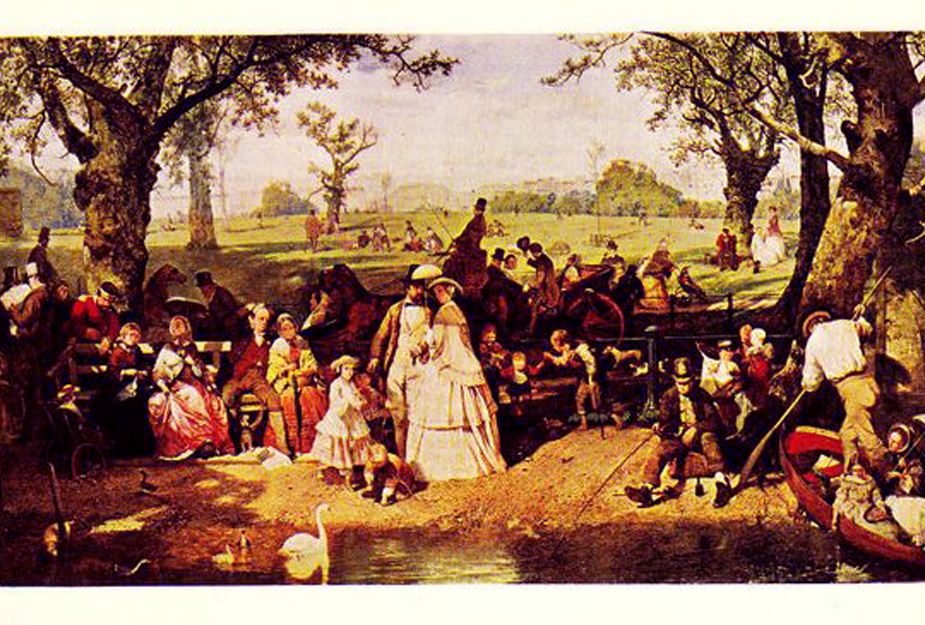
Painting by Ritchie, 1858 “A Summer’s Day in Hyde Park” shows the mixing of classes in Britain
Victorian fashion had everyone dressing like a queen… .. under Victoria, Britain grew, expanded – literally boomed in every way. She was a champion of British technology, arts, sciences, and fashion. In every situation she required, or at the very least, suggested, British goods be used in manufacture of textiles and clothing. The new wealth of the rising middle class of merchants and tradesmen allowed everyone to dress like a queen.
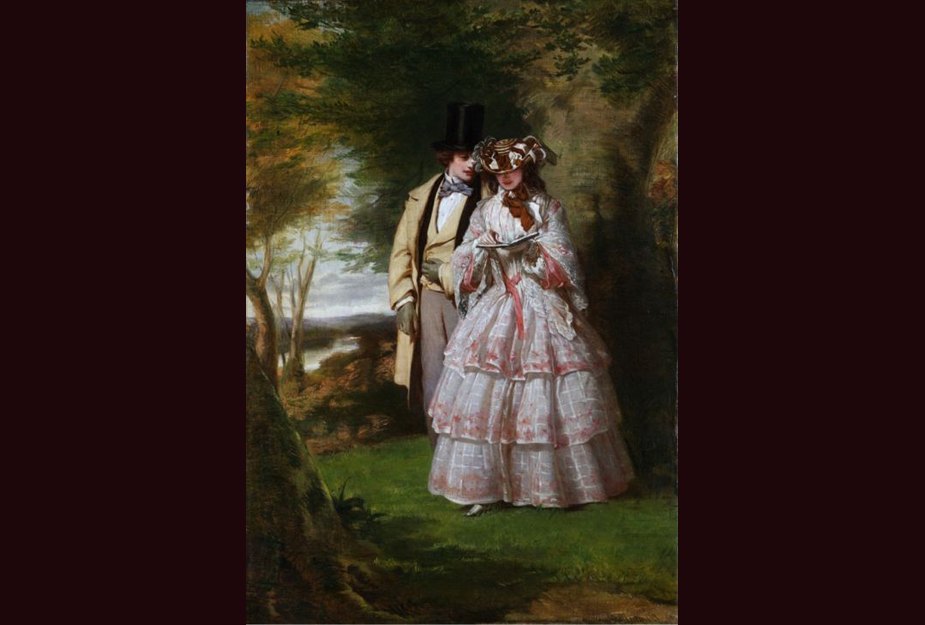
1840’s “Derby Day” painting by Firth shows the classes mixing at the horse races
The wedding of Victoria and Albert set fashion trends… Breaking all the previous “rules” of fashion, Victoria insisted on wearing white to her wedding, establishing the “rule” for that activity.. forever. Her dictates from this point on, told all Britains (and so all other countries who were following their lead) what was appropriate to wear on what occasion.
Note: this is just before photography became available. Her early reign is documented in portraits and sketches. Her late reign and her children would be well documented, especially since her daughter Beatrice would become a photographer and have her own dark room.
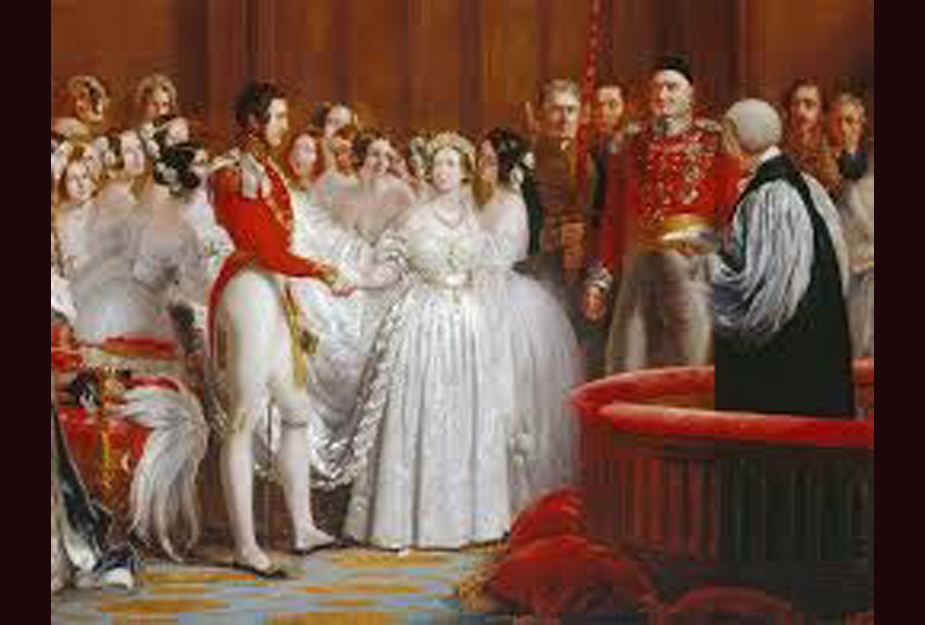
In 1840, Queen Victoria was married to Prince Albert
Queen Victoria ordered guests to wear… .. specific items such as British made lace, or Scottish plaids. She held balls and activities that specifically order the participants to dress a certain way, however, the many levels and the complexity of the time in many countries. Victoria did set fashion trends, but they were interpreted differently by different women in differing situations.
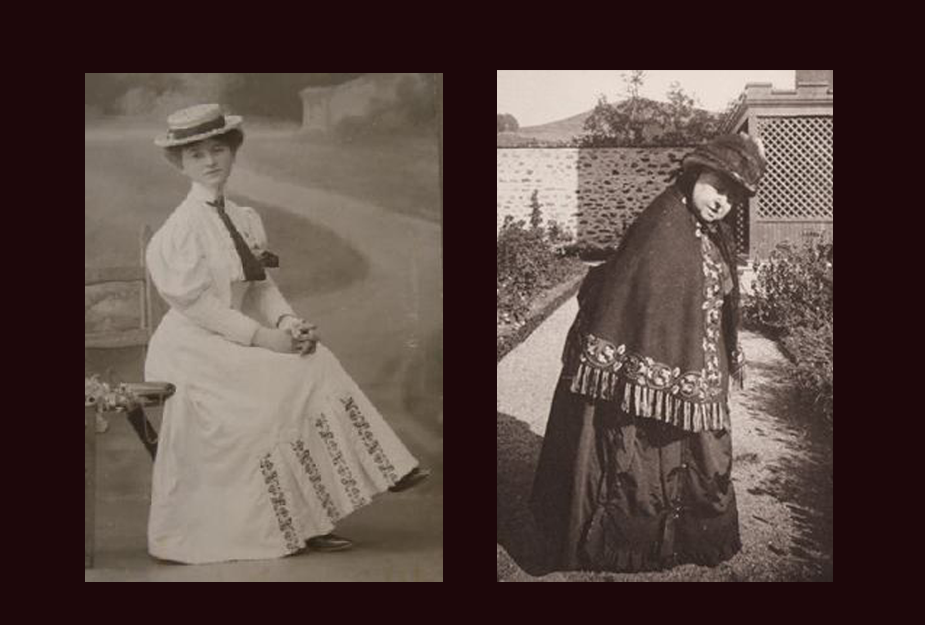
1889 Women at leisure: left – merchant class English woman in walking suit; right – Queen Victoria in a very different and royal kind of mourning/walking suit
A Victorian woman’s place was in the home
While the houses, streets, and many of the gadgets we use today were just earlier versions of what we have today (pianos, carpet sweepers, sewing machines), the main difference was the place of women in society.
There were of course, independent women with original thoughts, and the expression of that varied with region and country. The Victoria Era spanned 64 years, so it would be wrong to lump everyone as having one same lifestyle. As the era closed, attitudes would shift drastically towards reform in laws pertaining to women, but in general throughout the time, society made life much easier for women if they accepted that a woman’s place was in the home.
Women “stayed by the hearth.. whilst men…” … wielded their swords.” (Tennyson). The prevailing attitude of men towards women in the Victorian Era was that all women were weak and helpless fragile and delicate flowers incapable of making decisions beyond selecting the menu and children were taught moral values.
A gentlewoman ensured that the home was a place of comfort for her husband and family from the stresses of Industrial Britain.
“(A wife’s) prime use is to bear a large family and maintain a smooth family atmosphere where a man need not bother himself about domestic matters so he can get on with the making of money.” (“Beeton’s Book of Household Management“)
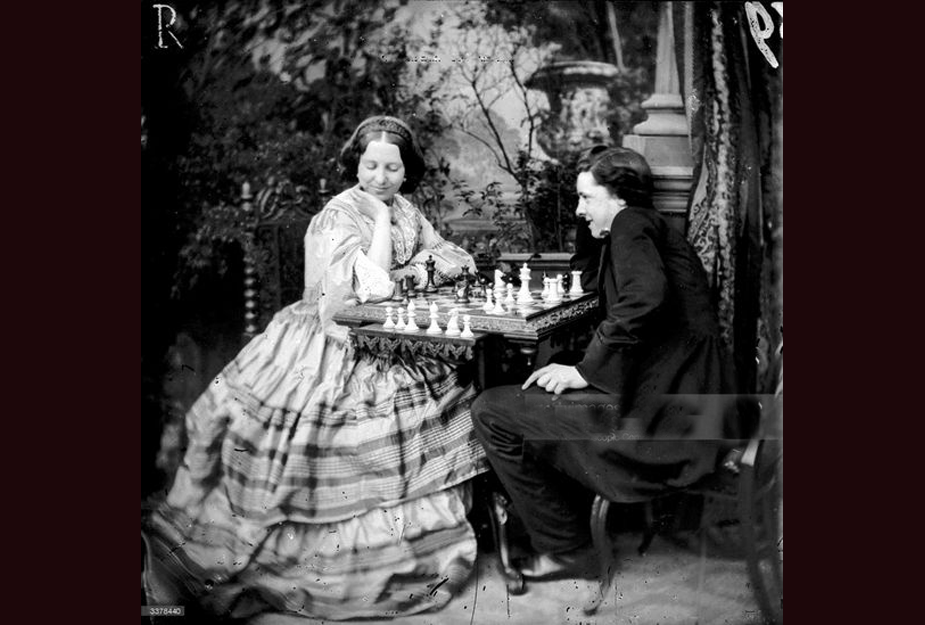
In the 1840’s, young women were taught to let the man win in a game of chess
The objective of the “proper” Victorian woman was… …marriage. Girls were groomed like racehorses in preparation for that, making sure she could sing, play an instrument, speak foreign languages, and above all be innocent, virtuous, biddable, dutiful, and ignorant of all intellectual opinion.
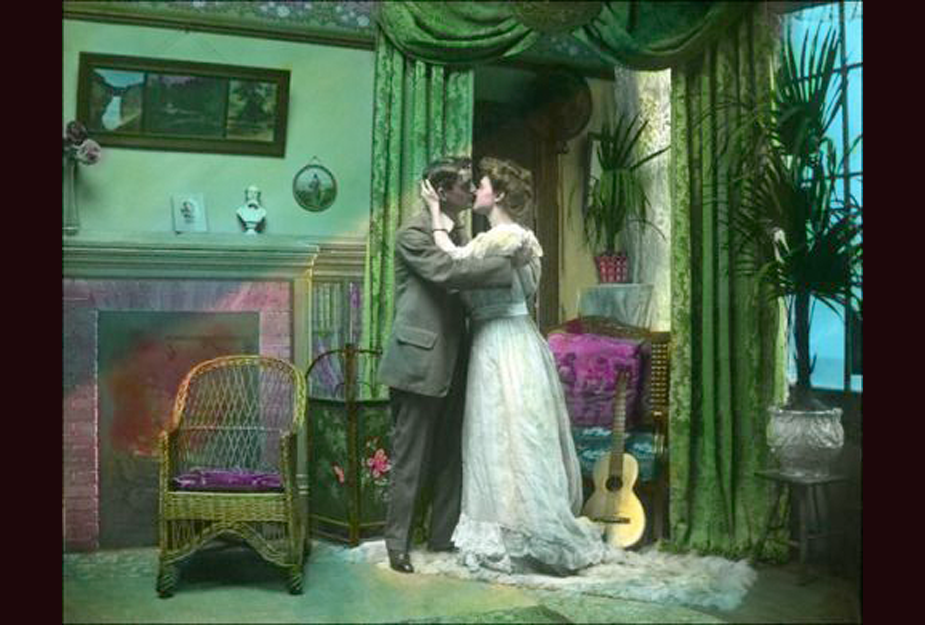
Dating in 1860’s upper Manhatten, USA
Victorian wives were required to be faithful… .. even though husbands kept mistresses, and were free to mingle in their “gentlemen’s clubs” where they could find a warm welcome among male friends, and often comfort in a woman’s.
If a women took a lover it was never to be made public because if it did become public knowledge she would be cut by society. If she divorced, she would have zero chance of acceptance in society again, although men easily moved on to the next relationship.
As a result, it was a time where relationships were quite artificial, for upper and merchant classes at least.
Until 1887 a woman could not own property, and even that which she inherited from family was turned over to her husband the day of their marriage. She herself was “owned” by her husband. In 1887 the Married Woman’s Property Act gave English women rights to her own property.
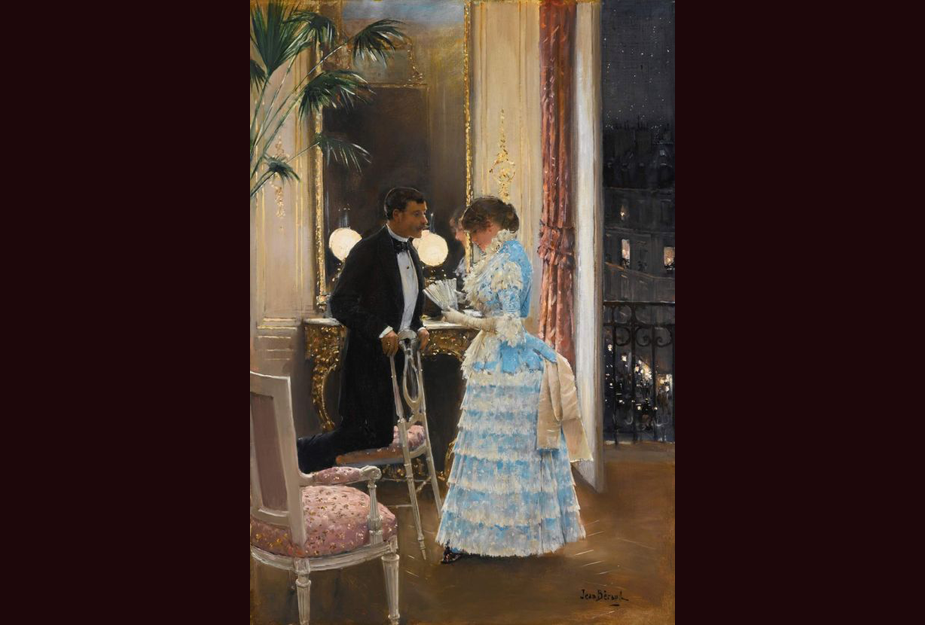
Flirting in a Parisienne Salon in the 1880’s
Life for wealthy vs poor Victorian women of Britain… … was very different. An affluent wife was supposed to spend her time reading, sewing, receiving guests, going visiting, letter writing, seeing to the servants, and dressing the part of her husband’s social representative.
Her clothing was made specifically to show off wealth, and that became more and more lavish as the 1800’s progressed until rich women’s outfits literally “dripped” with lace, beads, ribbons, and bows. She had up to 6 wardrobe changes a day which changed over 3 seasons a year.
In contrast the very poor wife of Britain wore clothing handed down and remade, typically “5th hand”. They ate food leftovers from rich households, and what they bought was often inferior stringy meat, old bread, cheese, herring, porridge, or kippers.
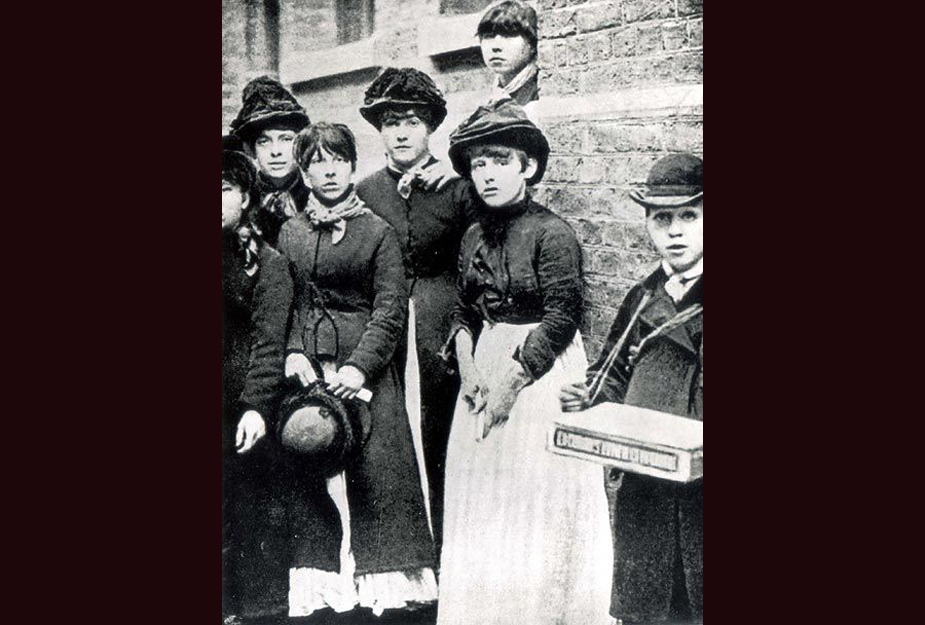
Bryant May mill workers; working lower class women of London
For wealthy, noble, and elite Victorian women.. … Victorian fashion required different ensembles for different occasions. Designer Charles Worth, an Englishman-turned-Parisian-designer, introduced the word “costume” at this time, and Victoria expanded upon the concept for her country.
“Costume” meant there was morning and mourning dress, walking dress, town dress, visiting dress, receiving visitors dress, traveling dress, shooting dress, golf dress, seaside dress, races dress, concert dress, opera dress, dinner and ball dress.
Fashion plates were hugely successful in this era giving ladies supposed to women visual clues on how to dress for their new found status. New activities were invented just to show off status through “costume”, such as parading around city parks in carriages.
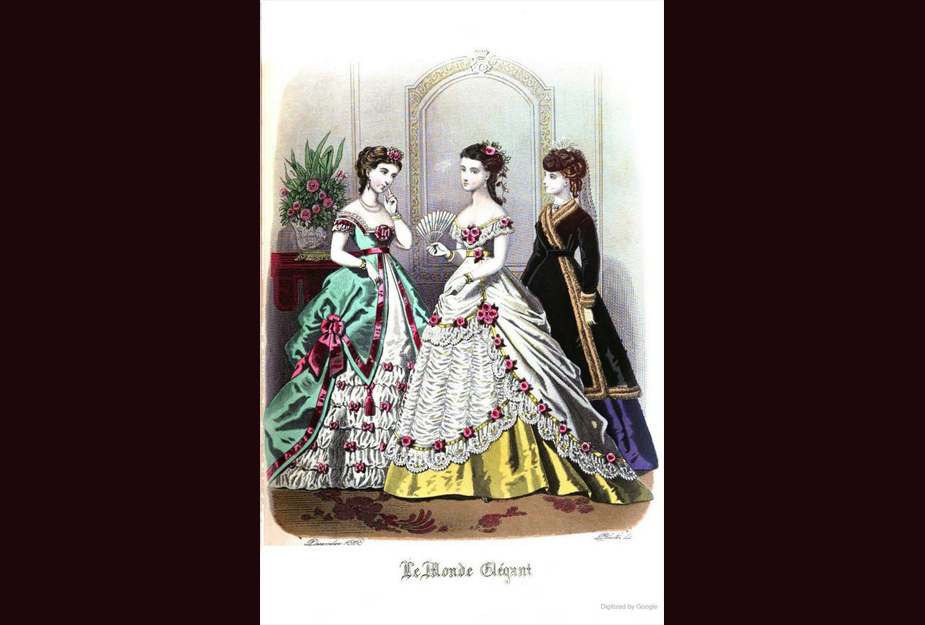
1868 Victorian fashion plate which shows women how to dress in Costume
Change in Victoria’s Britain was happening… …everywhere and at all social and class levels. New inventions and how to use them opened doors for poor women to improve their situations through work. Acceptance of women as thinking beings as the era progressed closed the gap to give women common causes to rally around. The place men and women were equal was in the use of new “gadgets’, because no one could figure them out. The dynamics of men and women, and poor and wealthy, changed as the Victorian Era progresses.
By 1900 the railway, typewriter, telephones, post, camera, sewing machine, synthetic fabric fibers, and the bicycle became used in every day life. Women became secretaries, operators, and opened their own shops.
The Tailor Made Garment movement had women designing, making, and selling garments, as well as wearing them to work outside the home. The industry gave them credibility and confidence outside being just an asset to a husband.
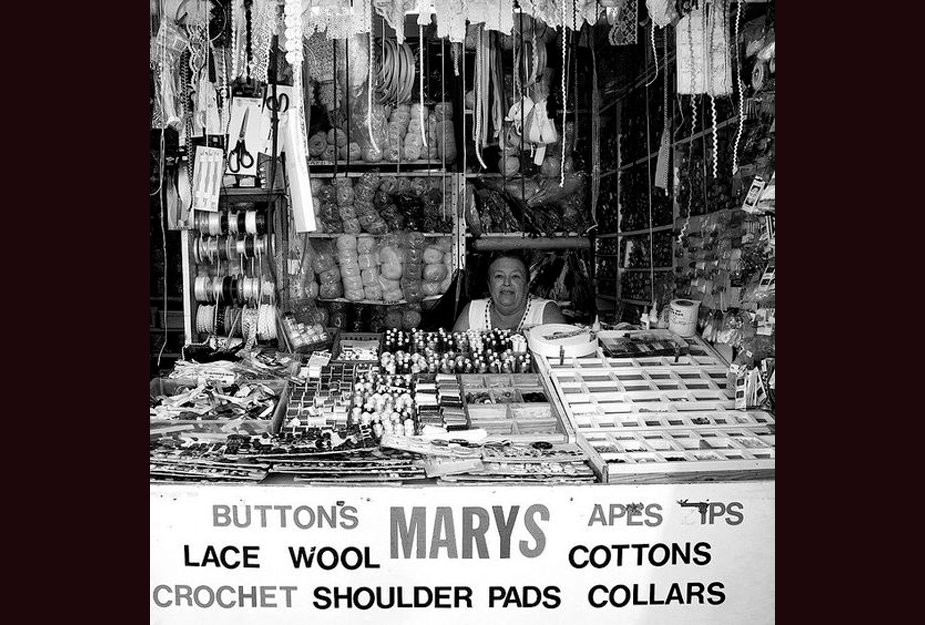
Mary’s Haberdashery in London started in the 1880’s and was still in business well into the 1980’s
Reform for women happened through the Victorian Era… … as Victorians began to recognize women as thinking people. As the year 1900 approached, women intellectuals began to speak openly. Many joined the Fabian Society, a group of socialists. Others sought reform for more practical dress (e.g. no corsets), better education, the right to keep their profits from paid work for themselves, better employment prospects, and better pay for women.
Most notoriously, women began the campaign in Britain that would lead thinking women around the world to have the right to vote and for birth control. The Victorian Era would be known for beginning the women’s rights movement worldwide.
Historians break Victorian fashion into eras… … and there were many as Queen Victoria reigned from 1837 to 1901. In the beginning, most fashions lasted about a decade, but by the mid 1850’s, mass communication and mass production had improved so much that by 1901 the history of fashion was moving in almost a yearly cycle.
Fashion, Politics, & Culture
Silhouettes breaks down the eras into six using key features like bustles, crinolines, and sleeves into “early,””mid”,”late”, and “pre-Edwardian. There were actually many, many more subcategories and countermovements such as aesthetic and reform dress in those years (as per sketch featured).
The 1st Victorian Fashion Era was… …considered by historians to be Queen Victoria of England’s early reign, 1837-1860. In this time she was a teen, was crowned, was married, and had all of her children. In the industrial and technical world of this time frame, movements like the Rational Dress Reform Society and the Aesthetic Dress Movement arose in reaction to what was going on economically and socially.
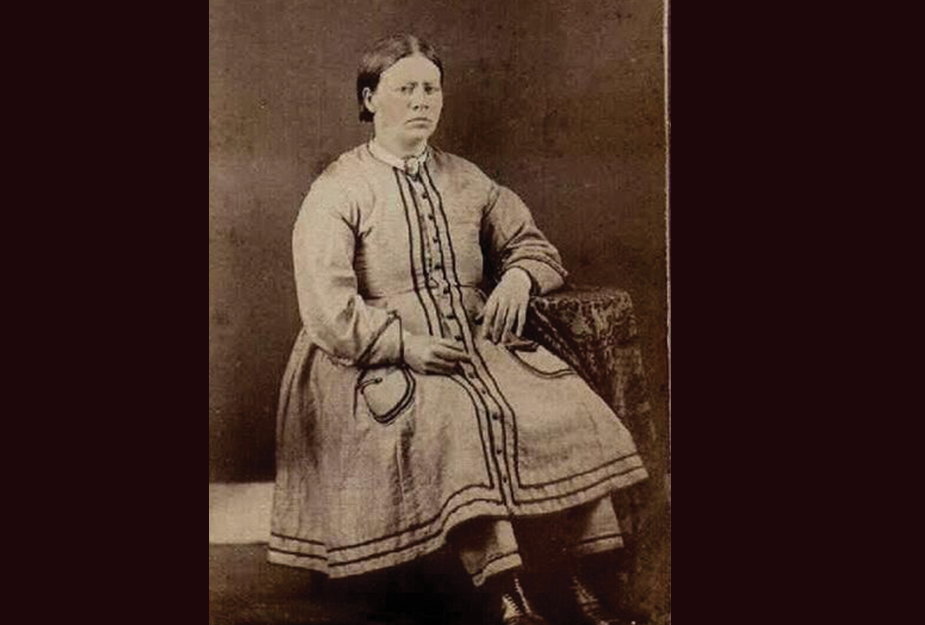
Bloomers were introduced to society in 1855 by the Reform Movement, but were only worn by women in insane asylums
The Rational Dress Movement during the Victorian era also introduced… … soft and comfortable corsets, approved by physicians. The concept of wearing something other than highly “trussed”, constricted style that had been in vogue since the invention of metal grommets in 1822, was indeed challenged by many throughout history, yet few women embraced the idea.
The position of a woman in society in the Victorian Era was reflected by dress. Anything less than the prevailing silhouette was considered vulgar and demeaning by most women.
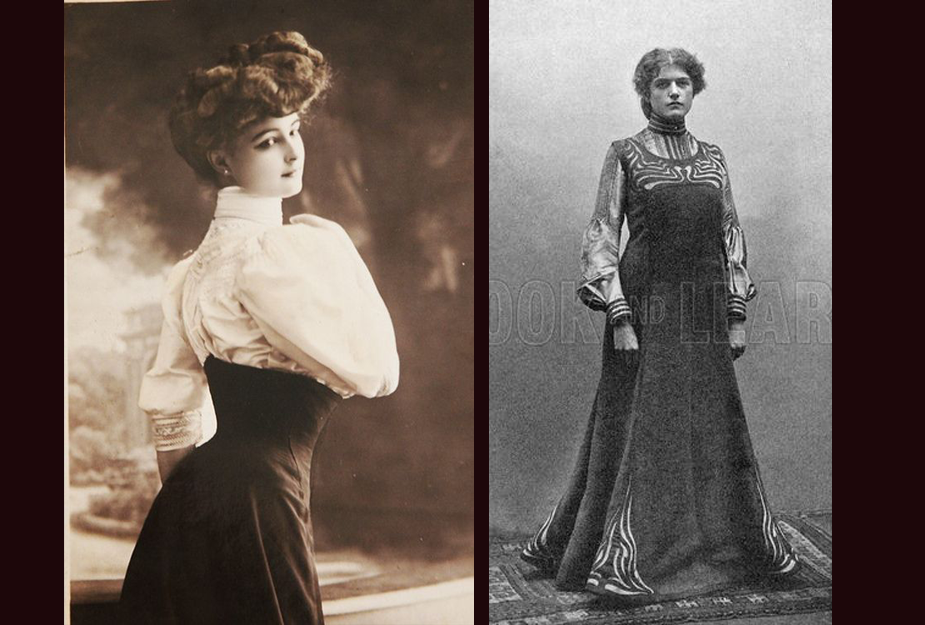
Left – 1890 Gibson Girl the ideal of that day was very constricted and shaped vs Right – the wife of Reform Movement leader in her Reform (corsetless) gown in 1903
The Aesthetic Fashion Movement came out of… .. the Reform Movement. Aesthetes saw fashion as ugly machine made products from the Industrial Revolution. Their dislike ranged from distaste for the ugliness of false structures and veneers to the crudeness of synthetic dyes to the over working of Victorian imagery.
They ignored the benefits of cheap costs for mass produced goods for those of low income or those who wanted to imitate upper classes on a lower budget.
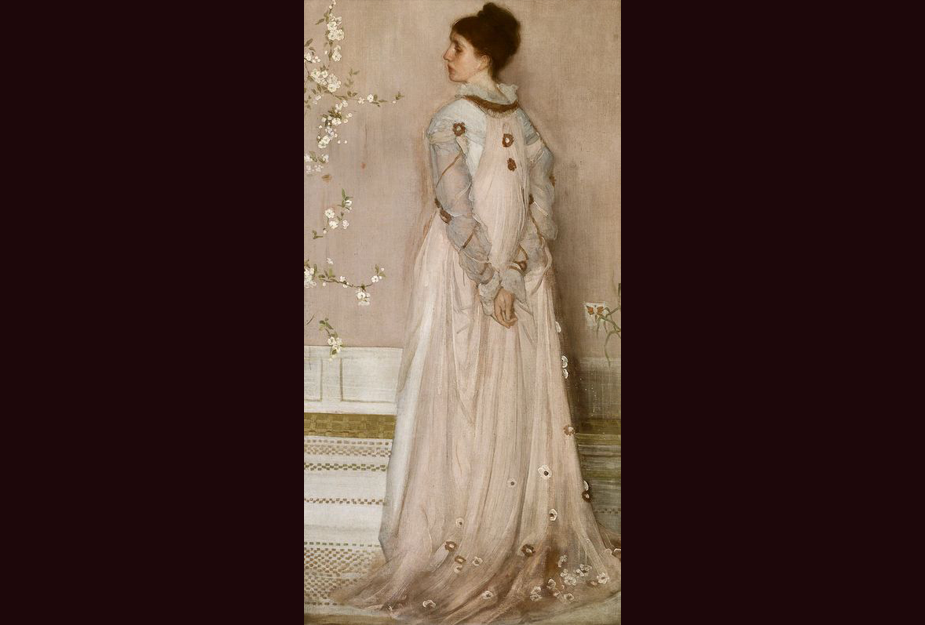
Mrs. Frances Leyland in Aesthetic dress about 1874
Aesthetes hated sewing machines… … because it allowed excessive embellishment of dresses because trims were so cheap with mass production and because trimming could easily be added at home or in the shop. Aesthetes were dangerous to vegetables… The Aesthetic (“counter fashion”) movement within and counter to the Victorian fashion era went beyond textiles and fashion. Aesthetes were also often vegetarians and campaigned for animal welfare rights.
They objected to the use of feathers on hats and the use of whole dead birds as a hat ornament. Modern vegetarianism has its roots in this movement.
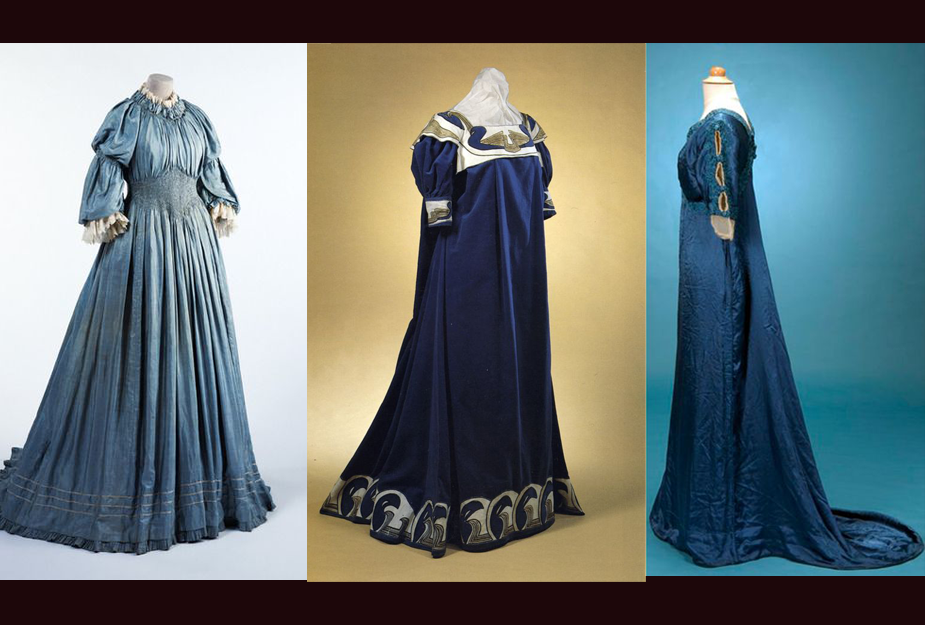
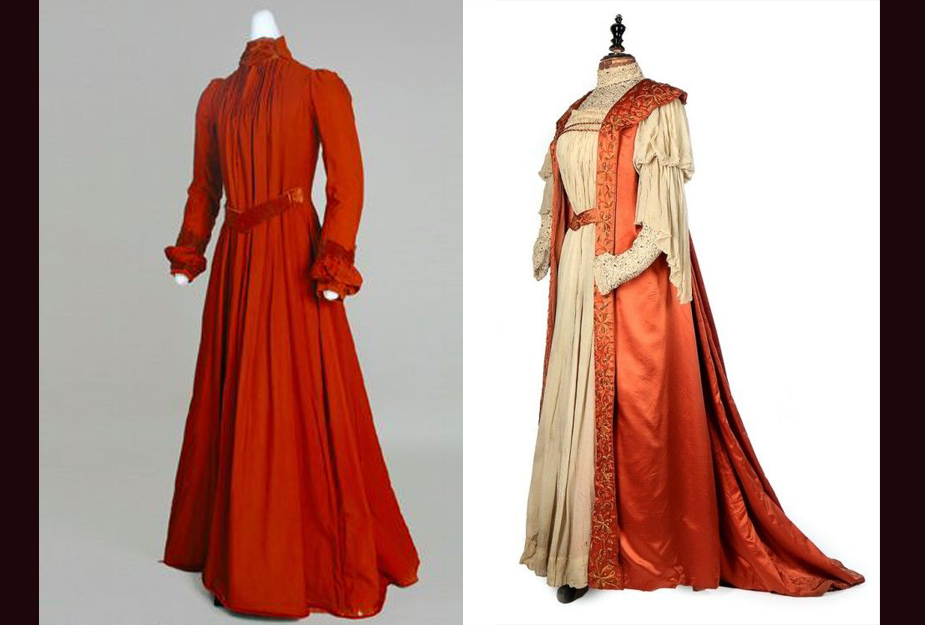
1897 Aesthetic tea gowns. They loved this carrot orange color!
The Aesthetic movement was technically 1870-1880… … in the mid-Victorian Era, although it got its start in reform and the early eras and in response to industrialization and mass production. They were a group of talented artists, poets, writers, and actors.
The leader was painter William Morris. He and architect Voysey designed houses together being fastidious about every detail from wallpaper to furniture, to window and fireplace proportions. Morris designed textiles and embroideries which he produced through his company Morris and Co.
Many of his original flowing organic designs are still used today, although the colors are adjusted to suit modern tastes.
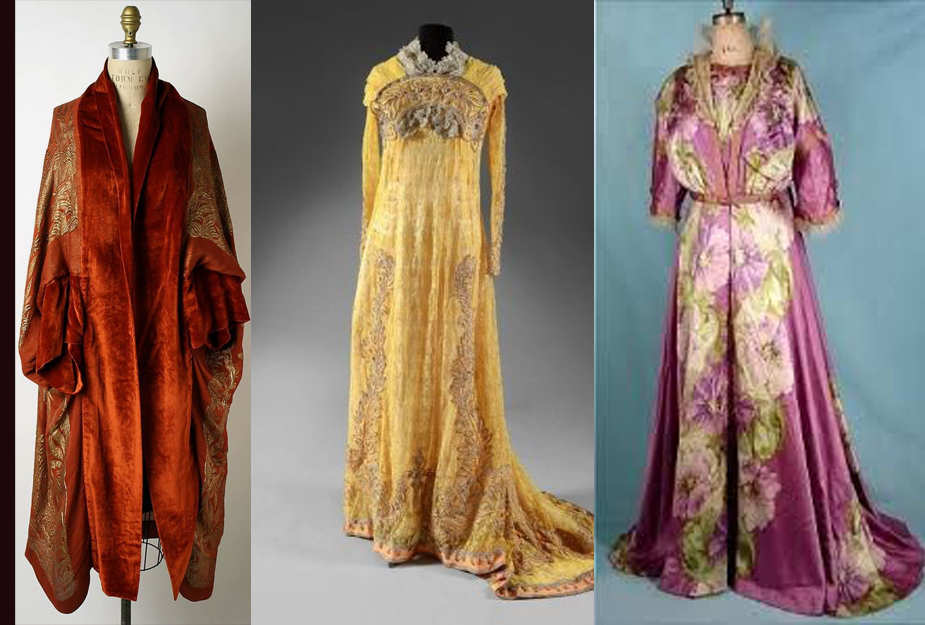
1900 Aesthetic gowns
Paintings were the inspiration for Aesthetes… …as they were influenced by the Pre-Raphaelite paintings of Dante Gabriel Rossetti and Edward Burne Jones who idealized medieval life in imaginary ethereal scenes. The women in these paintings appear to wear no corsetry and have freedom and “naturalness” that was admired by the Aesthetes.
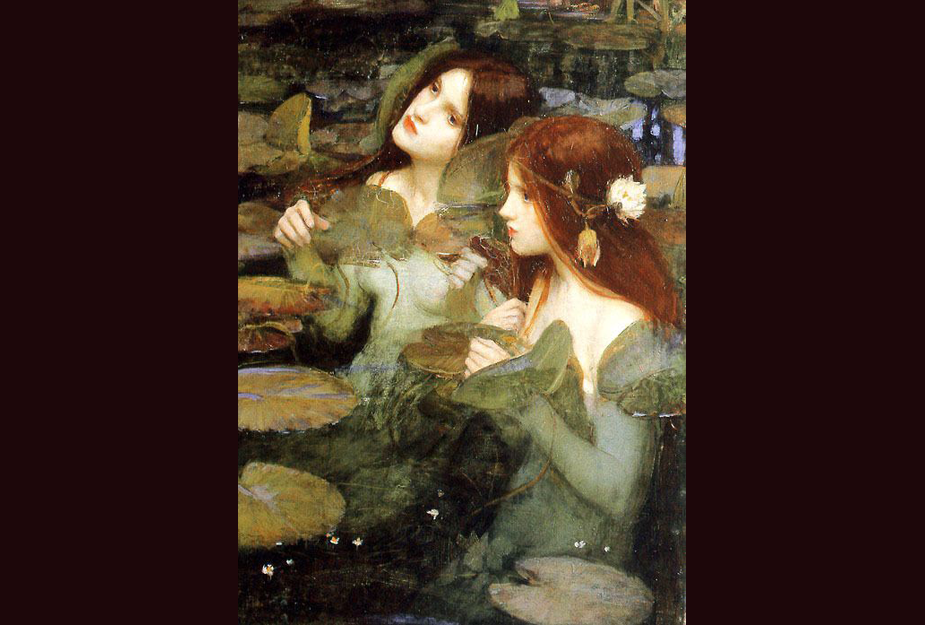
Painting by Pre-Raphaelite leader J.W. Waterhouse “Hylas and Nymph”
Pre-Raphaelites who inspired Aesthetes were artists… .. in the 19th century who despised the “schooled” method of art that was prevalent in the day which required certain lighting, levels or realism, and specific rules. Pre-Raphaelite art was often erotic, sensual, and depicted women scantily clad in dreamlike settings with mythological themes.
The Aesthetic counter-Victorian fashion movement embraced the Pre-Raphaelite concepts of wanting to show the beautiful, natural, and organic forms of the body, plants, animals, and the world around them.
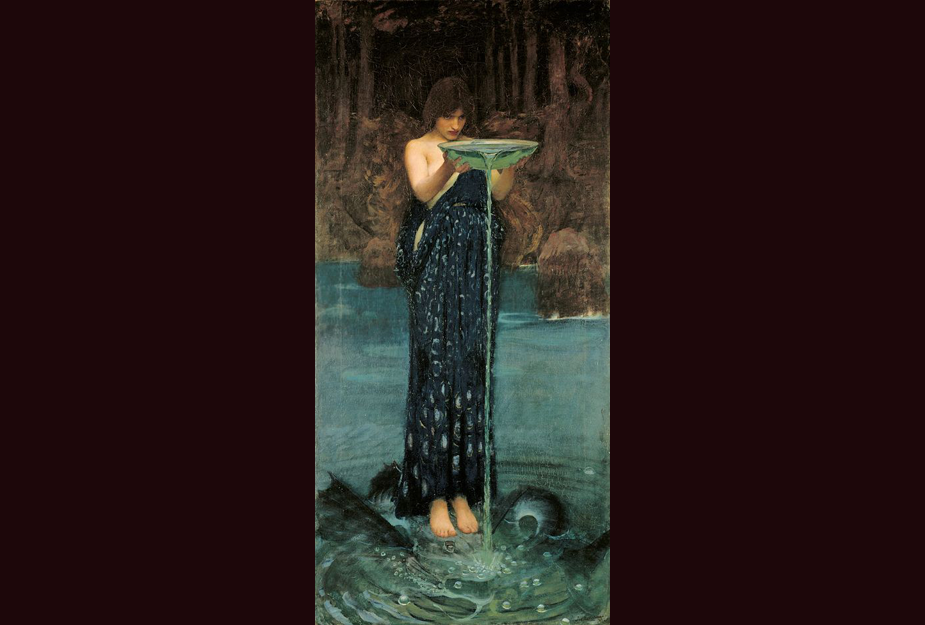
Painting: “Circe Poisoning the Sea” by JW Waterhouse, Pre-Raphaelite movement leader. Mythological themes, beautiful sensuous women, idyllic settings, and many plants and organic forms are the hallmarks of Pre-Raphaelite art
Pre-Raphaelites, Aesthetes, & Reformers… .. the counter design movements to the Victorian eras – the Pre-Raphaelites preceding and inspiring the Aesthetes, and the Reformers building on those concepts – took place worldwide, and predominantly in Europe.
As would be the Art Nouveau fashion movement in 1900, forms and styles were regional, meaning Prussia might have different interpretations than England or France of the same Aesthetic concept. Germany had a very strong Aesthetic influence.
Aesthetics did not limit themselves to fashion… … or fabrics. The Aesthetic movement within the Victorian fashion era were big in the development of interior design elements and architecture. Wallpaper, stained glass, and other highly crafted… … interior and exterior designs as well as beautiful fabrics were the Aesthetic Movement’s contribution to Victorian society.
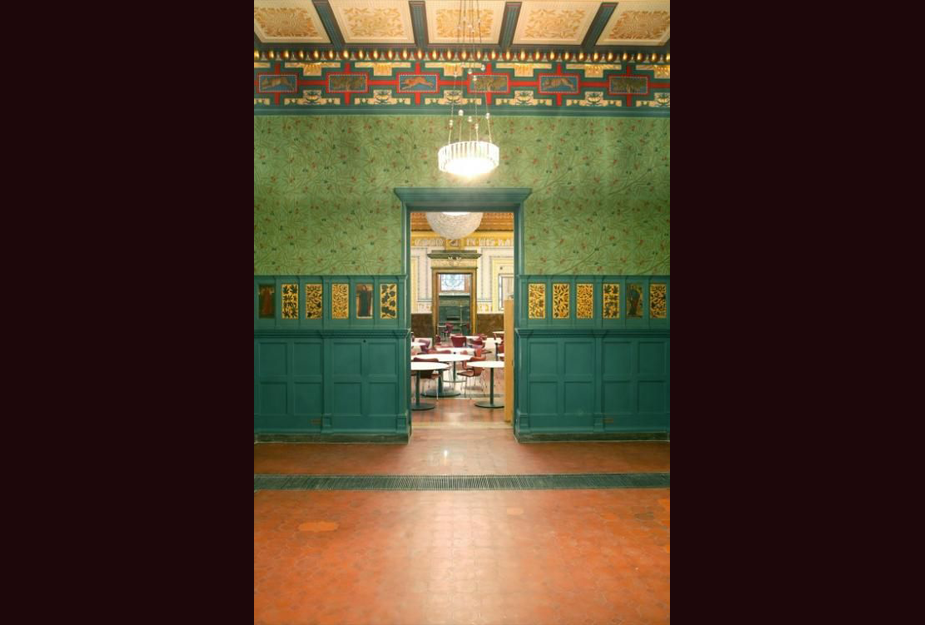
The Green Room in the Albert and Victoria Museum in London, was designed by William Morris, a leader of the Pre-Raphaelite movement, and inspiration for Aesthetes
Counter Victorian fashion movement Aesthetes felt women needed to look more like… … the nymphs and sensual creatures of art. To blend and suit these surroundings it was felt that some reform in style of dress was needed. Among artistic people the resulting fashion was known as Aesthetic dress.
The Aesthetes, like the Pre-Raphaelite painter J.W. Waterhouse, looked for sensuous beauty, organic forms, flowing movement, mythological and ancient themes, and rich colors and textures with amazing fabrics and highly crafted trims and details.
These themes would be carried not only in fashion, but in the Victorian Home.
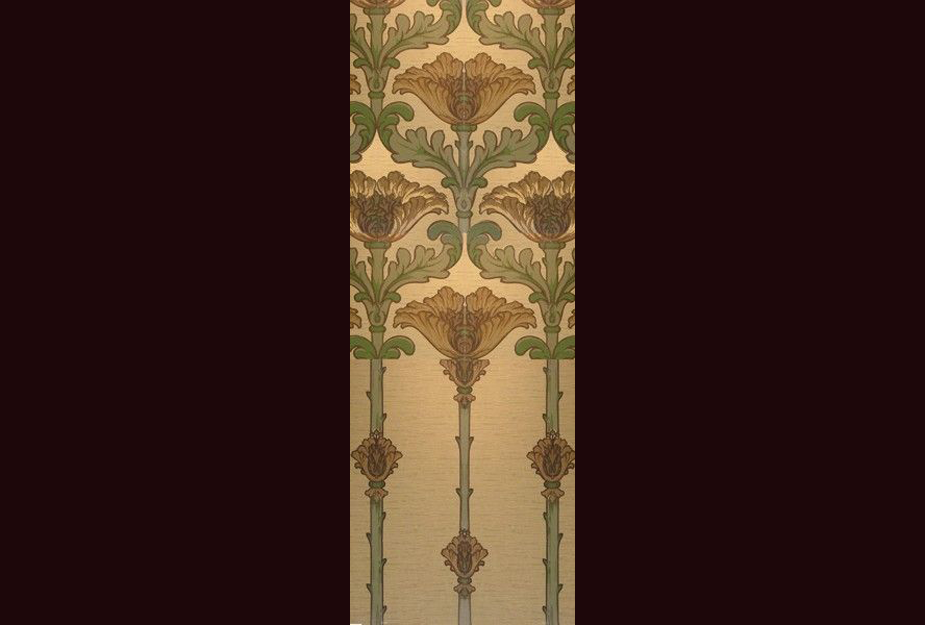
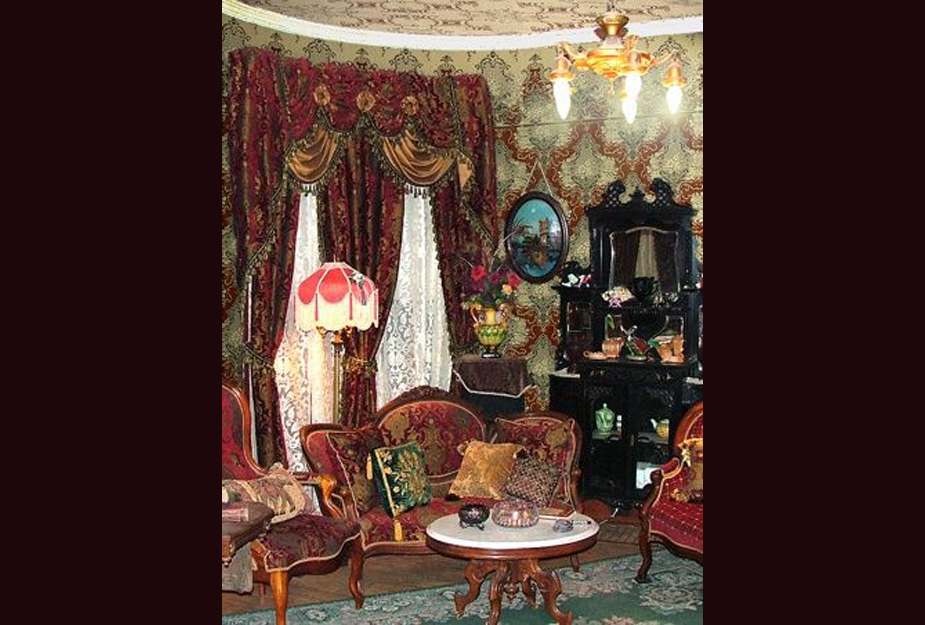
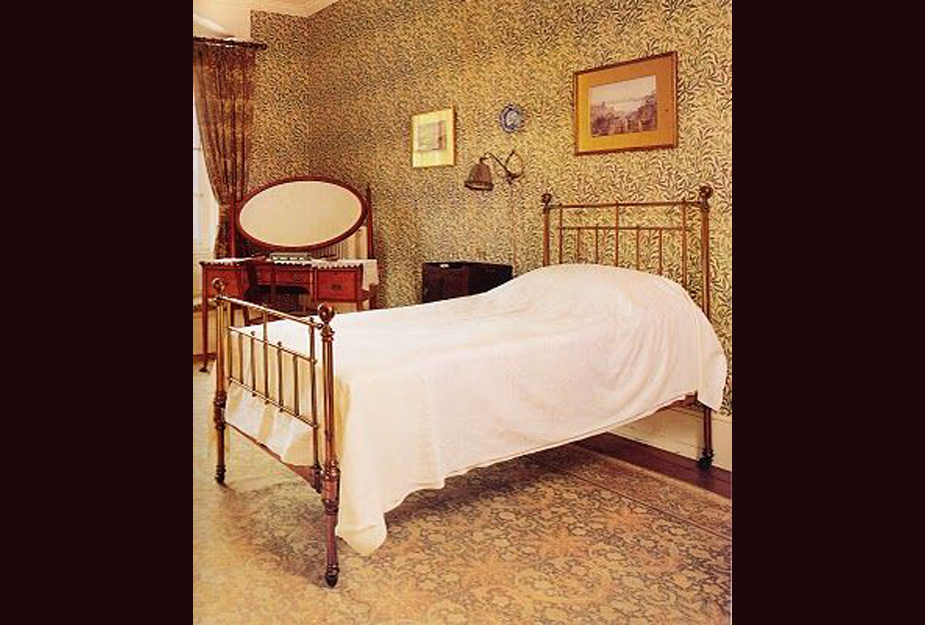
Aesthetic Wallpaper 1900, 1890’s parlor and bedroom with Aesthetic decor

Prosperity (intentionally) Seen Inside & Out
Changes happening in industry, transportation, and innovation brought a new kind of prosperity to the Victorians, and those who could wanted to show their status through their homes and lifestyles. People of the time associated heavy ornamentation and ostentatious display as showing off wealth. They crammed their homes full of furniture, bric-a-brac, and musical instruments like pianos to illustrated their refinement and good taste.
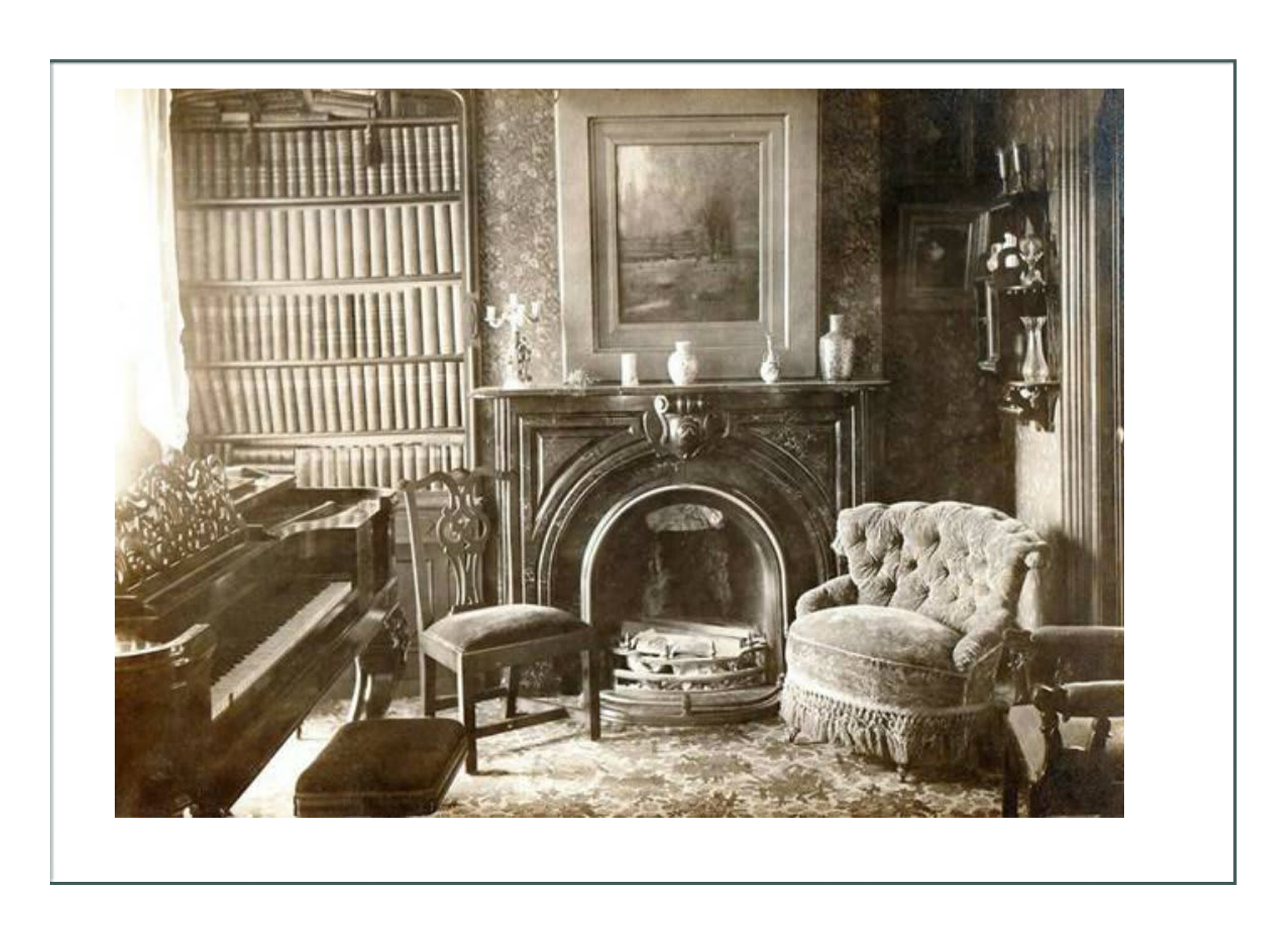
Interior Design – for Drama
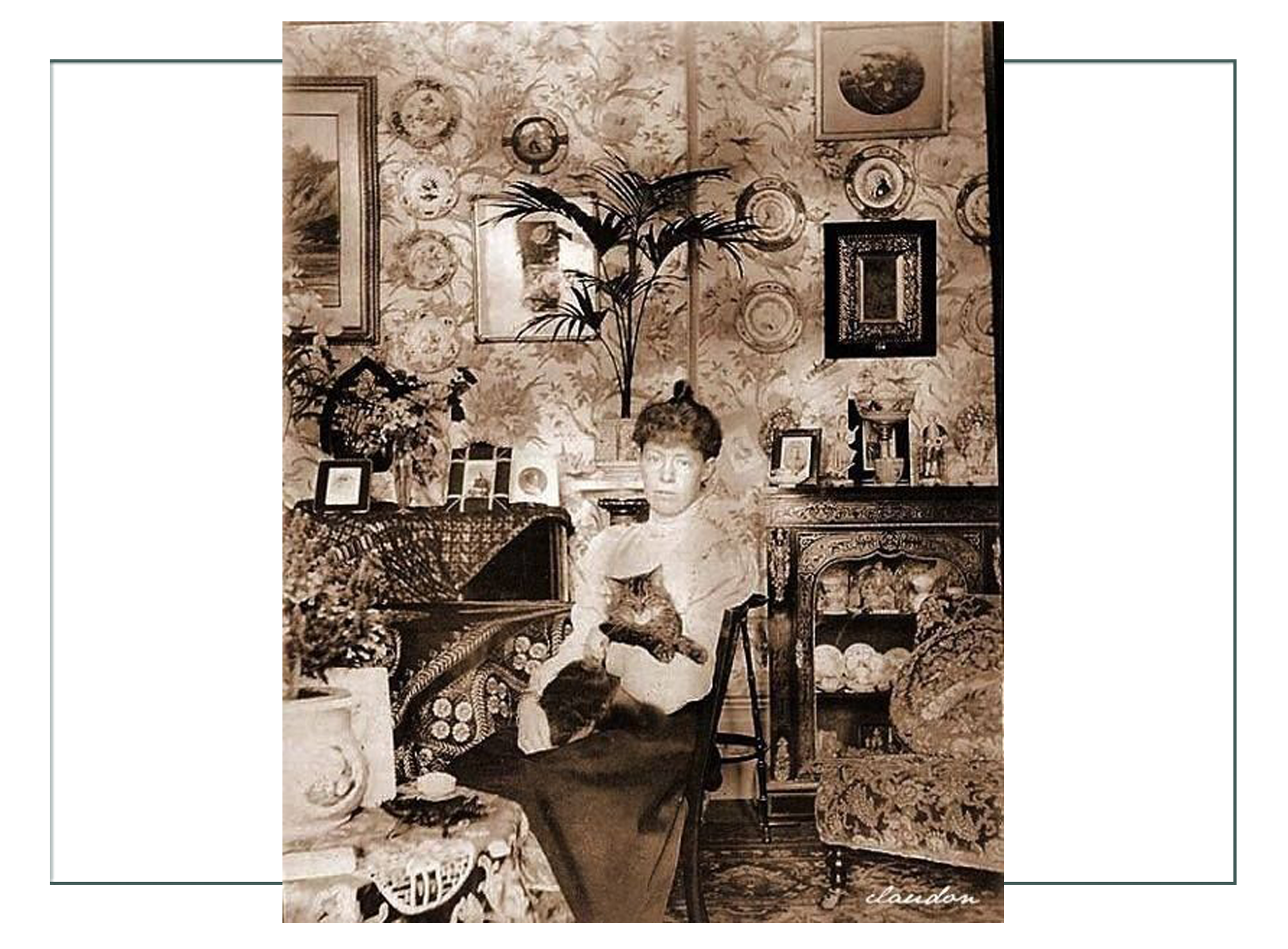
Much aligned with fashion of the day, heavy, balloon type furniture might have been a reaction to the earlier Regency styles of light and airy furnishings and clothing. Mahogany framed sofas were huge and magnificent with intricate carving. Polished woods like rosewood and heavy oaks were popular. Dark woods were throughout the house.
Vastness of scale in home furniture was essential starting in the 1860’s because the crinoline meant large seats were a must. Big, generous seats with round seat backs were a must. The 1830’s balloon back chair was popular into the 1860’s. In the 1850’s, the bentwood chair was popular. It was a decorative paper-mache chair inlaid with mother-of-pearl and had a cane seat. The bentwood was scrolled and gilded to excess.
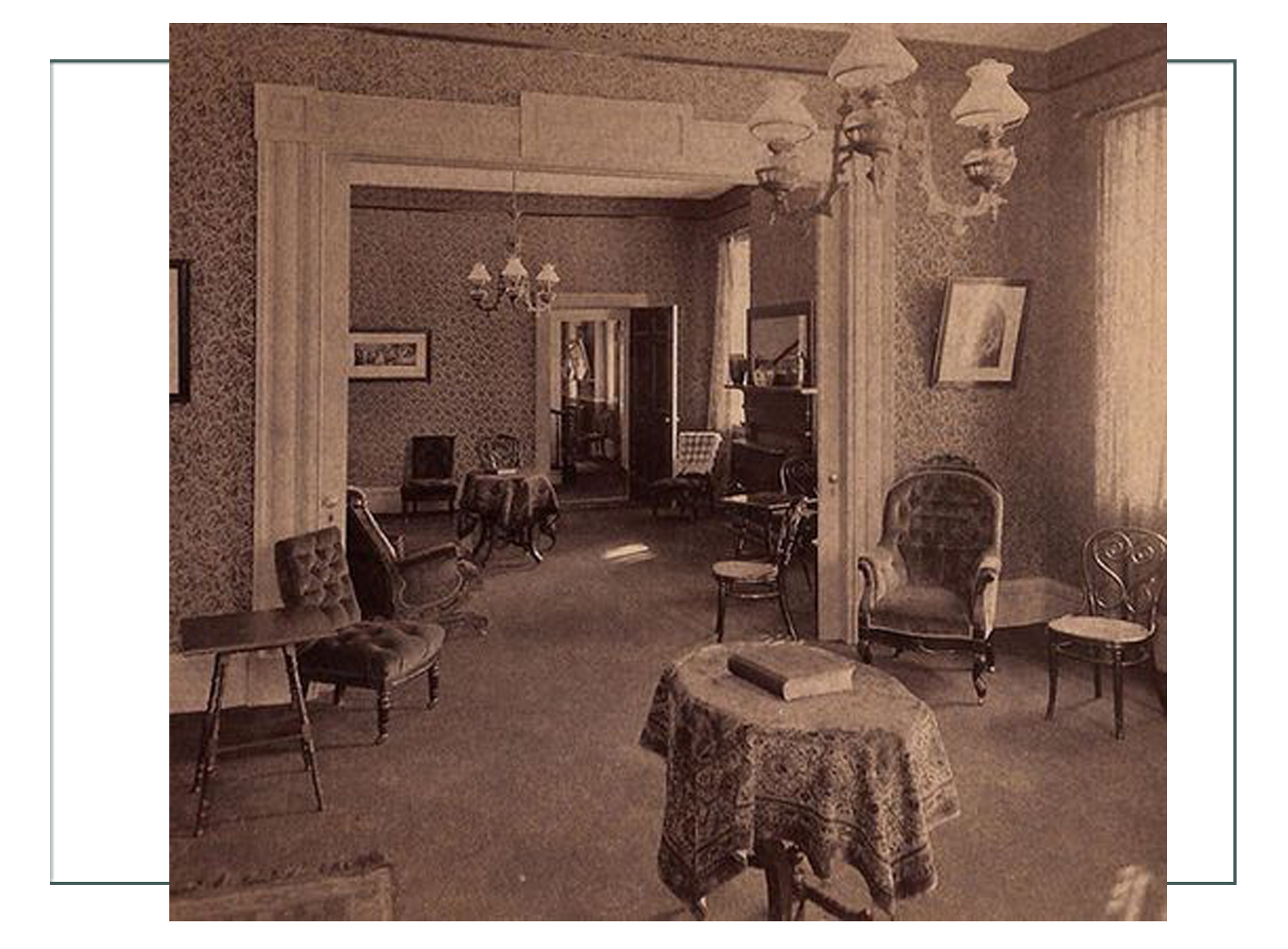
By the mid-1850’s staircases became extremely wide to accommodate skirts. Ladies used them to sweep down dramatically in a flurry of petticoats and silk. The double tete a tete enabled women to spread skirts and to avoid having to sit too near a man without becoming compromised by sitting too closely. The split backrest allowed couples to get to know each other in a restrained and respectable way.
Cluttered & Dark
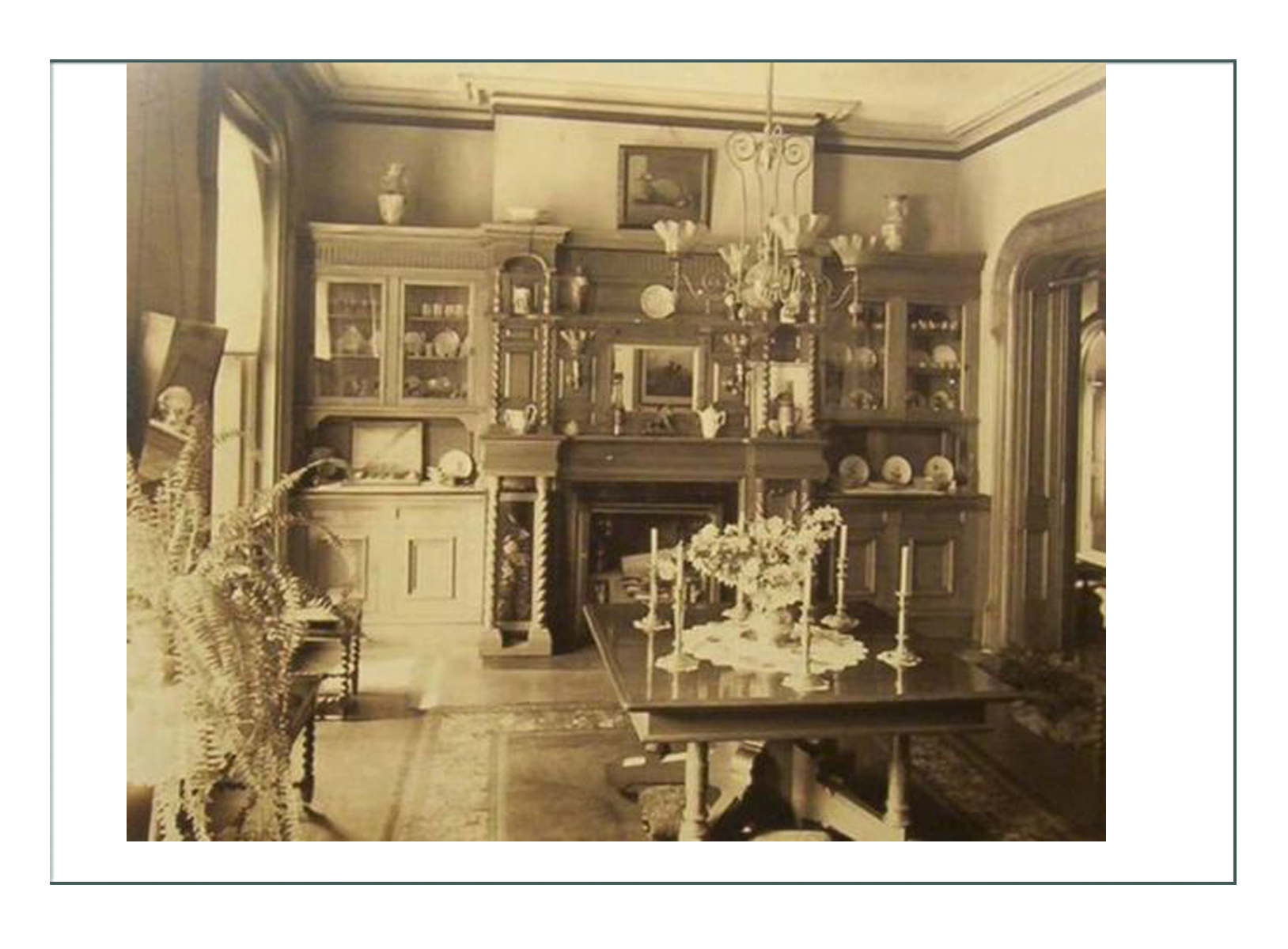
Home interiors were uite dark with busily patterned wallpaper. Sunlight was intentionally kept out of the already dark room by layers of blinds, lace curtains, velvet drapes, and side curtains made of dark colors. From a picture rail hung oil paintings, etchings, engravings, water colors, needlework, and embroidered reproductions of famous paintings.
All of this “stuff” was reflected by huge mirrors in every social space. Furniture and shelves were covered with fringed, beaded cloths and runners. The more a home could be over filled with china, domed wax flowers, stuffed birds, trinket boxes, the more it could reflect and multiply in the mirror. The homeowner felt the more he had, the higher his social status.
Samples of original and renovated 1890-1900 interiors are below. Note in-house bathrooms and plumbing with electric light fixtures in the higher class homes. These are the spaces where a domestic servant would work and promote the owner’s lifestyle.
Dining Rooms
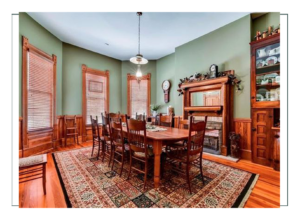
Kitchens
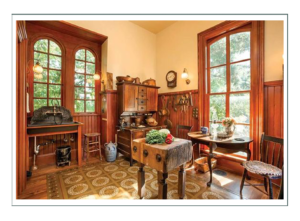
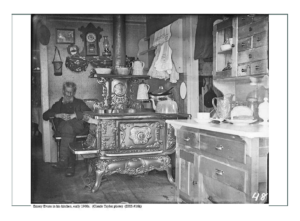
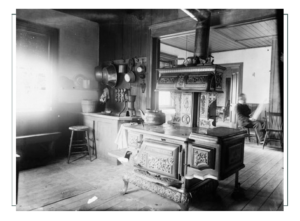
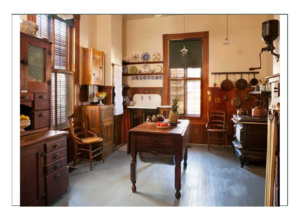
Pantries
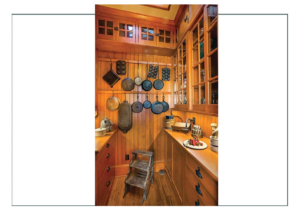
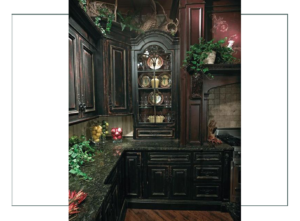
Bathrooms
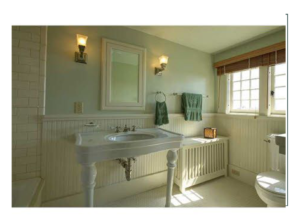
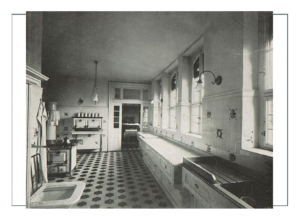
Parlors & Sitting Rooms
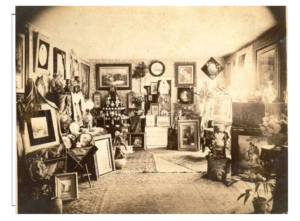
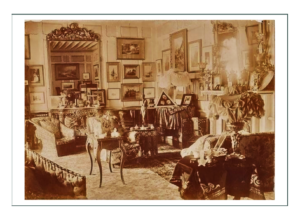
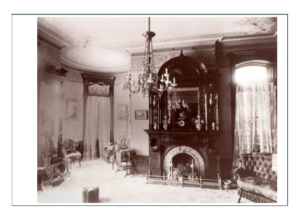
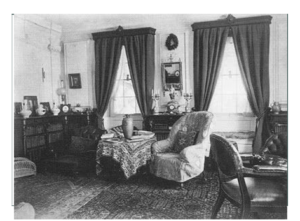
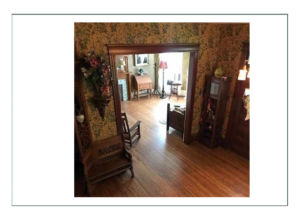
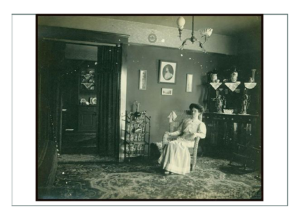
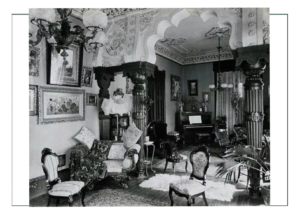
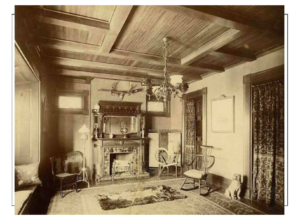
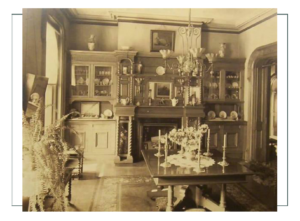
Sunrooms & Porches
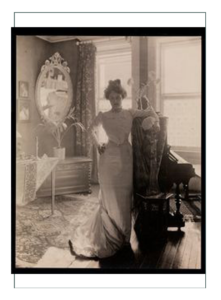
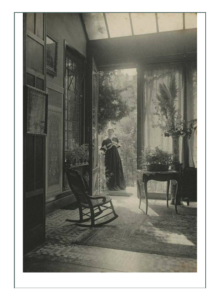
Bedrooms & Entryways
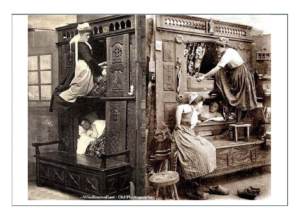
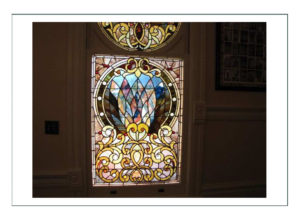
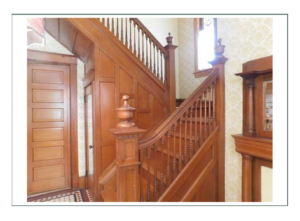
Exteriors and Architecture
(This Section Courtesy of HGTV.com)
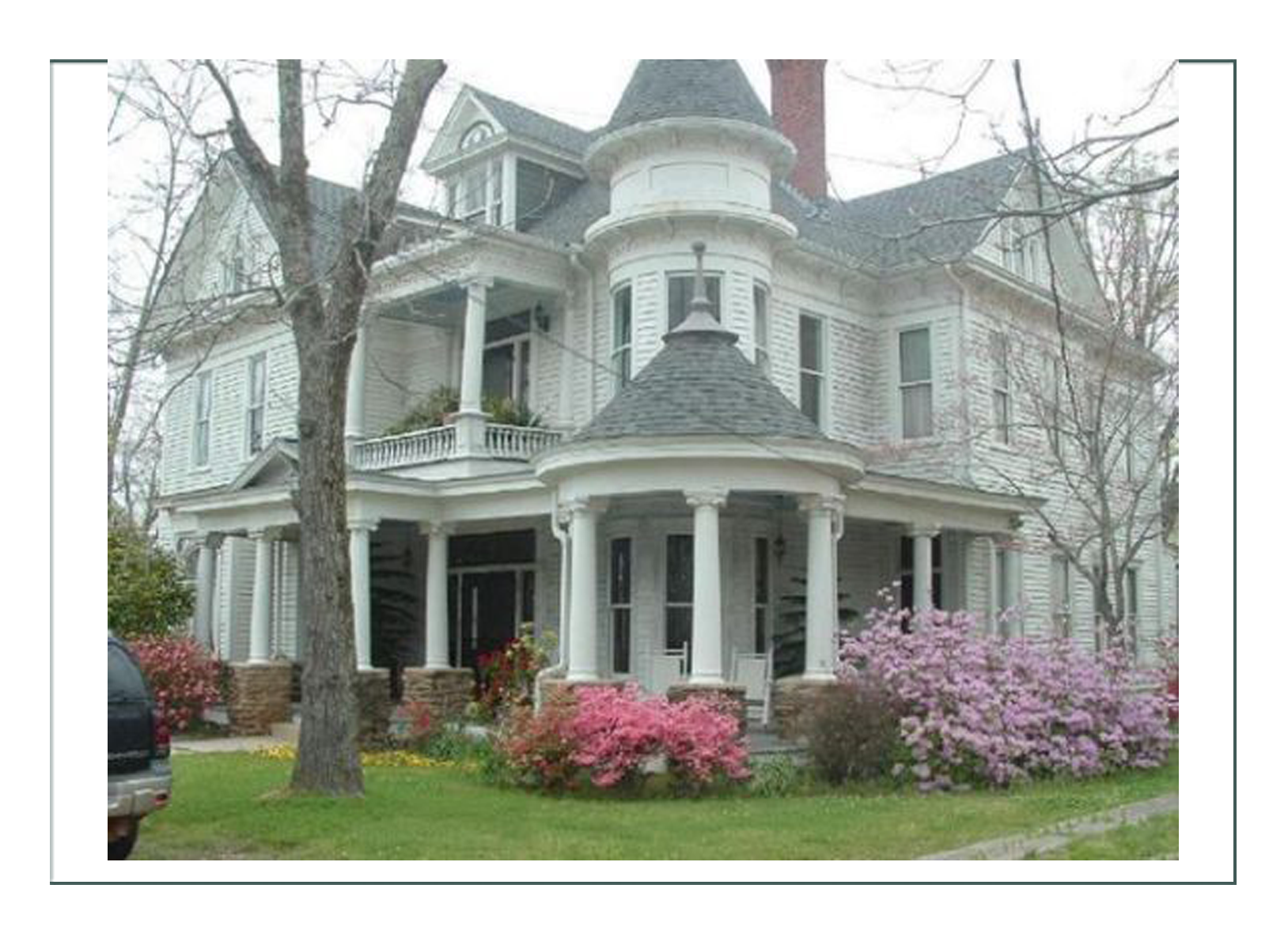
Status was also reflected by the size of a home, and the ability to show off by giving parties and hosting activities. Home life was designed to be shown off in this lifestyle that was “invented”. The most important status symbol was having domestic servants.
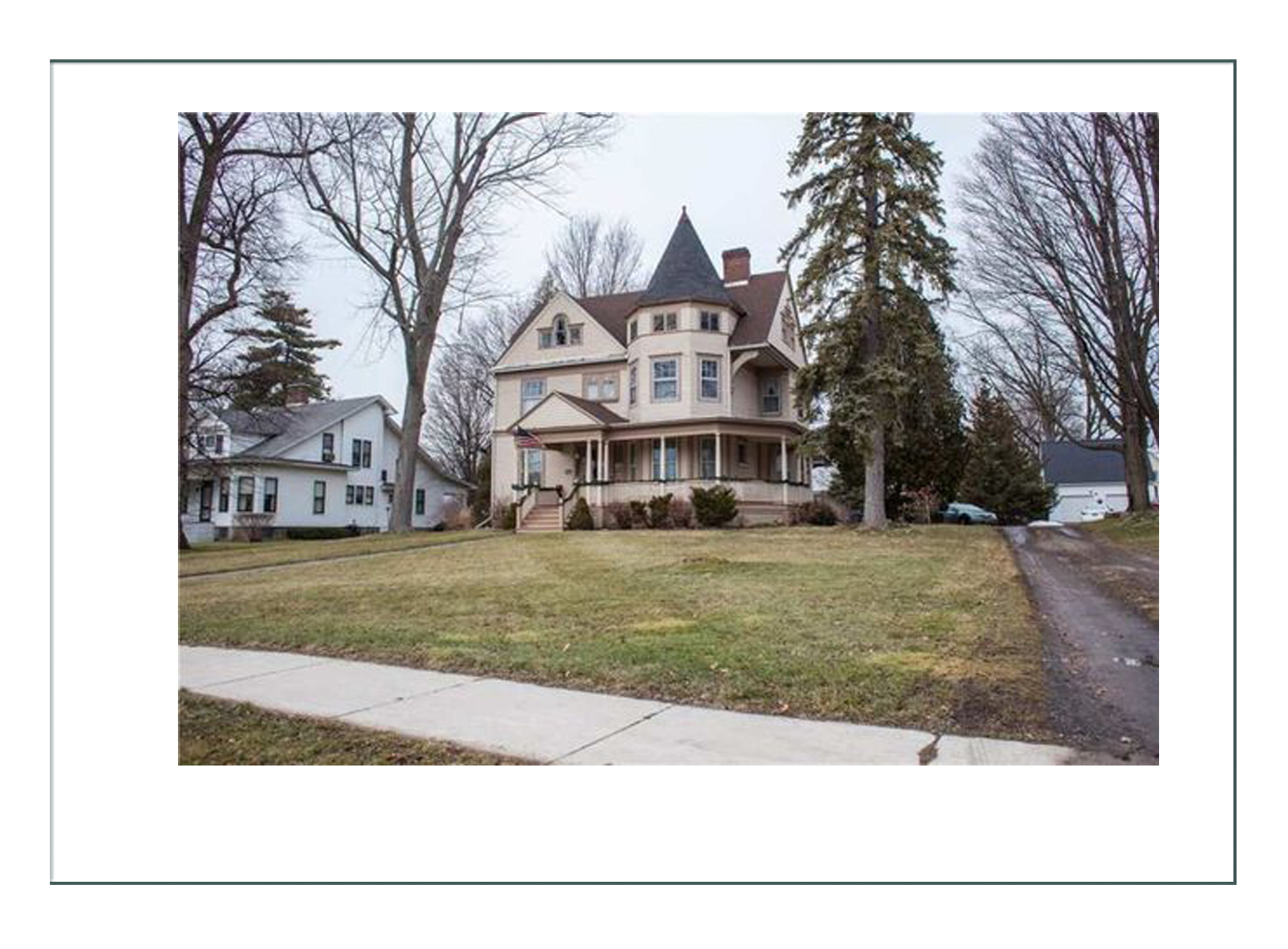
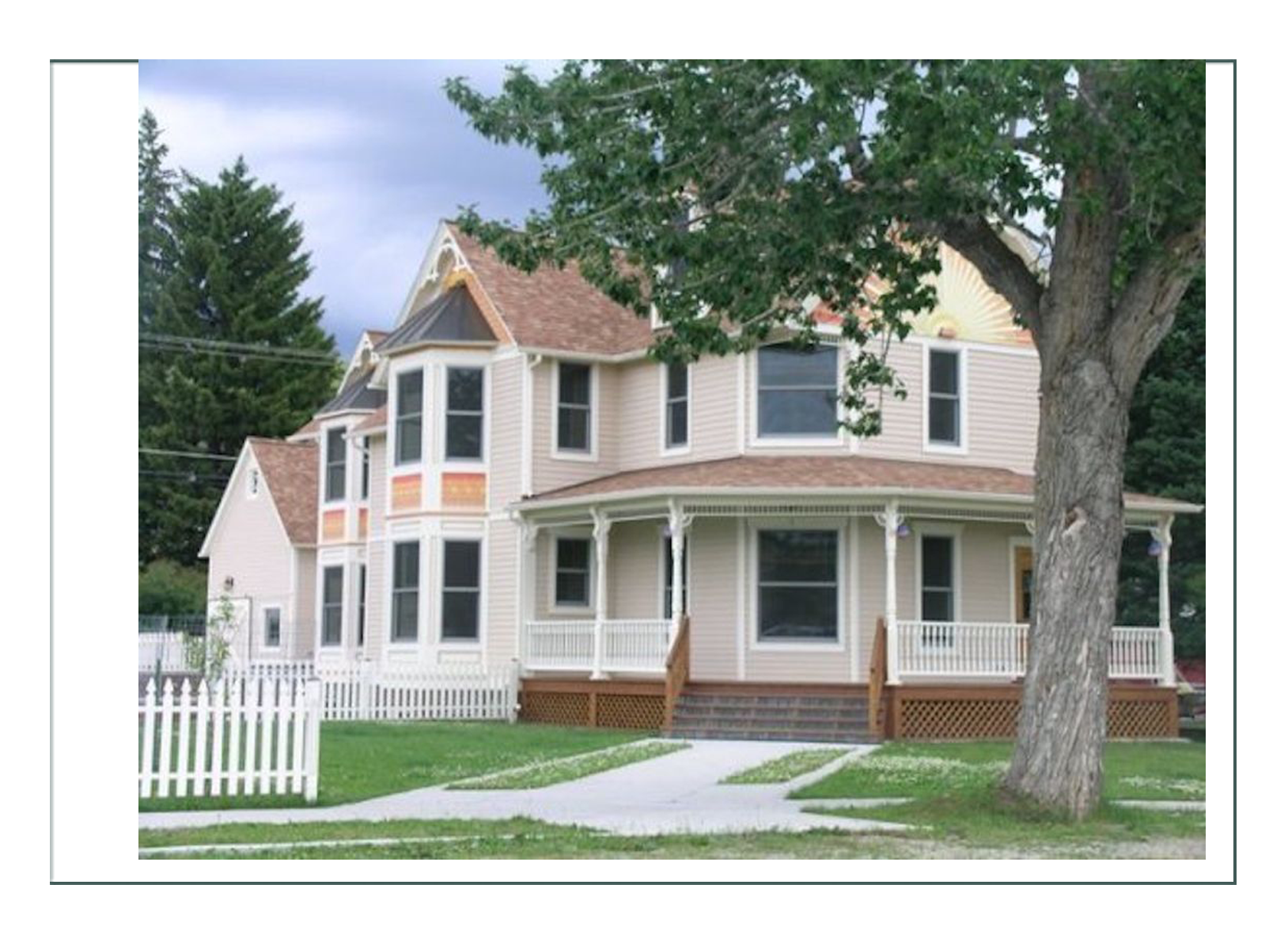
Key Elements
- Two to three stories. Victorian homes are usually large and imposing.
- Wood or stone exterior. The majority of Victorian styles use wood siding, but the Second Empire and Romanesque styles almost always have outer walls made of stone.
- Complicated, asymmetrical shape. Unlike the boxy Greek revival style, Victorian homes have wings and bays in many directions.
- Decorative trim. Commonly called “gingerbread,” Victorian homes are usually decorated with elaborate wood or metal trim.
- Textured wall surfaces. Scalloped shingles, patterned masonry or half-timbering are commonly used to dress up Victorian siding.
- Steep, multi-faceted roof or Mansard roof. Victorian homes often have steep, imposing rooflines with many gables facing in different directions. The Second Empire Victorian style has a flat-topped Mansard roof with windows in the side to allow for maximum space inside the house.
- One-story porch. A large, wraparound porch with ornamental spindles and brackets is common, especially in the Queen Anne style.
- Towers. Some high-end Victorian homes are embellished with a round or octagonal tower with a steep, pointed roof.
- Vibrant colors. Before the Victorian era, most houses were painted all one color, usually white or beige. By 1887, bright earth tones like burnt sienna and mustard yellow were in vogue.
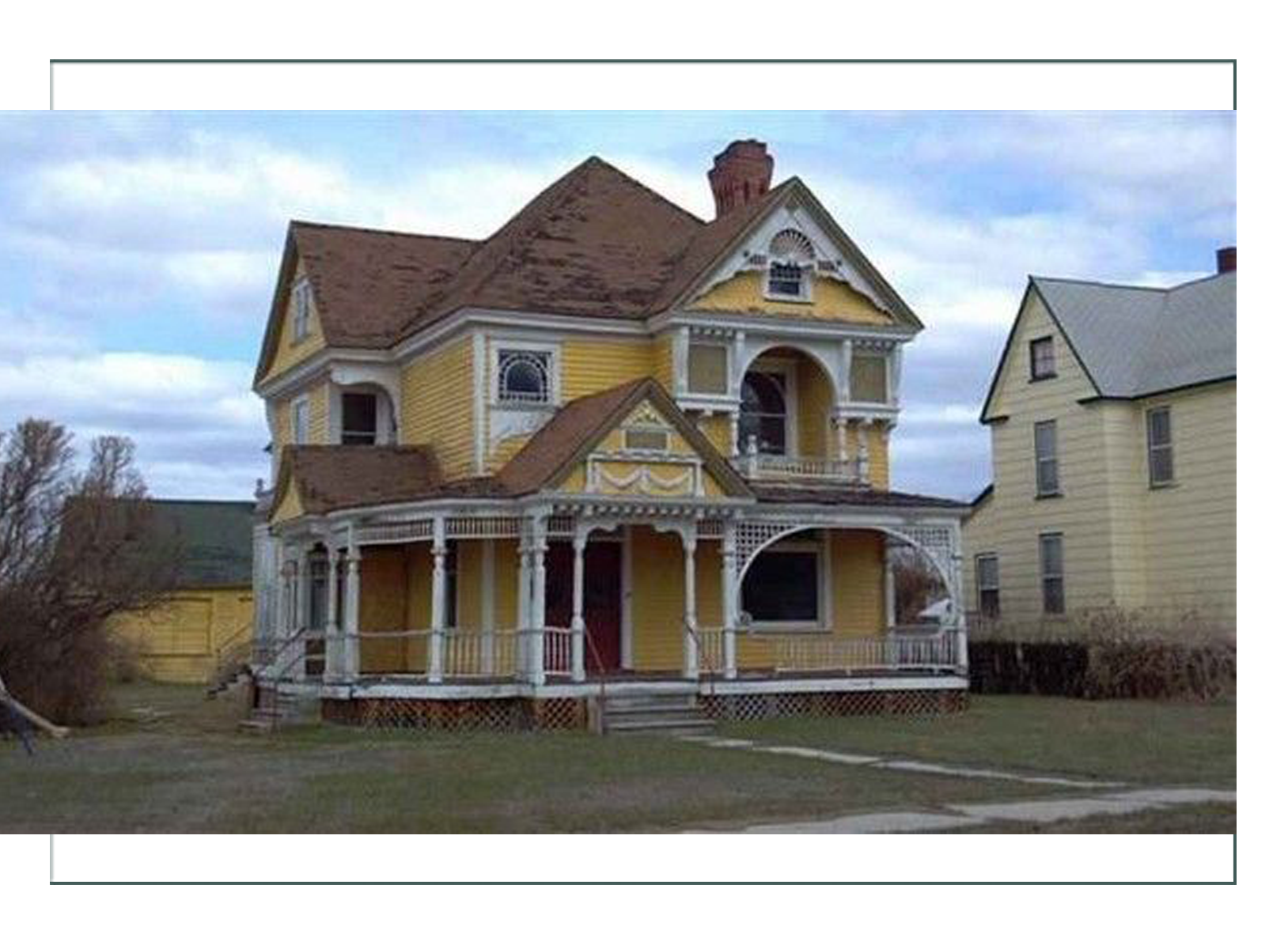
Famous Examples
- Gingerbread House. This Savannah, Ga., landmark was built by Cord Asendorf in 1889. It’s considered one of the best examples of Steamboat Gothic architecture.
- Wedding Cake House. This square brick home in Kennebuck, Maine, was originally built in 1826. Like many homes in the Victorian era, it was covered in wooden Gothic decoration in 1850 to keep up with architecture trends.
- “Painted Ladies” in San Francisco. The term “painted ladies” refers to Victorian houses painted in three or more colors to embellish their architectural detail. It was first used to describe the colorful homes in San Francisco in the 1978 book Painted Ladies: San Francisco’s Resplendent Victorians.
- Rosson House. Built in 1895, this Phoenix home is a great example of the Queen Anne style and is now a museum. Its detailed trim is often referred to as Eastlake detailing, after furniture designer Charles Eastlake’s elaborate creations.
Practically Speaking: Hassles and Headaches
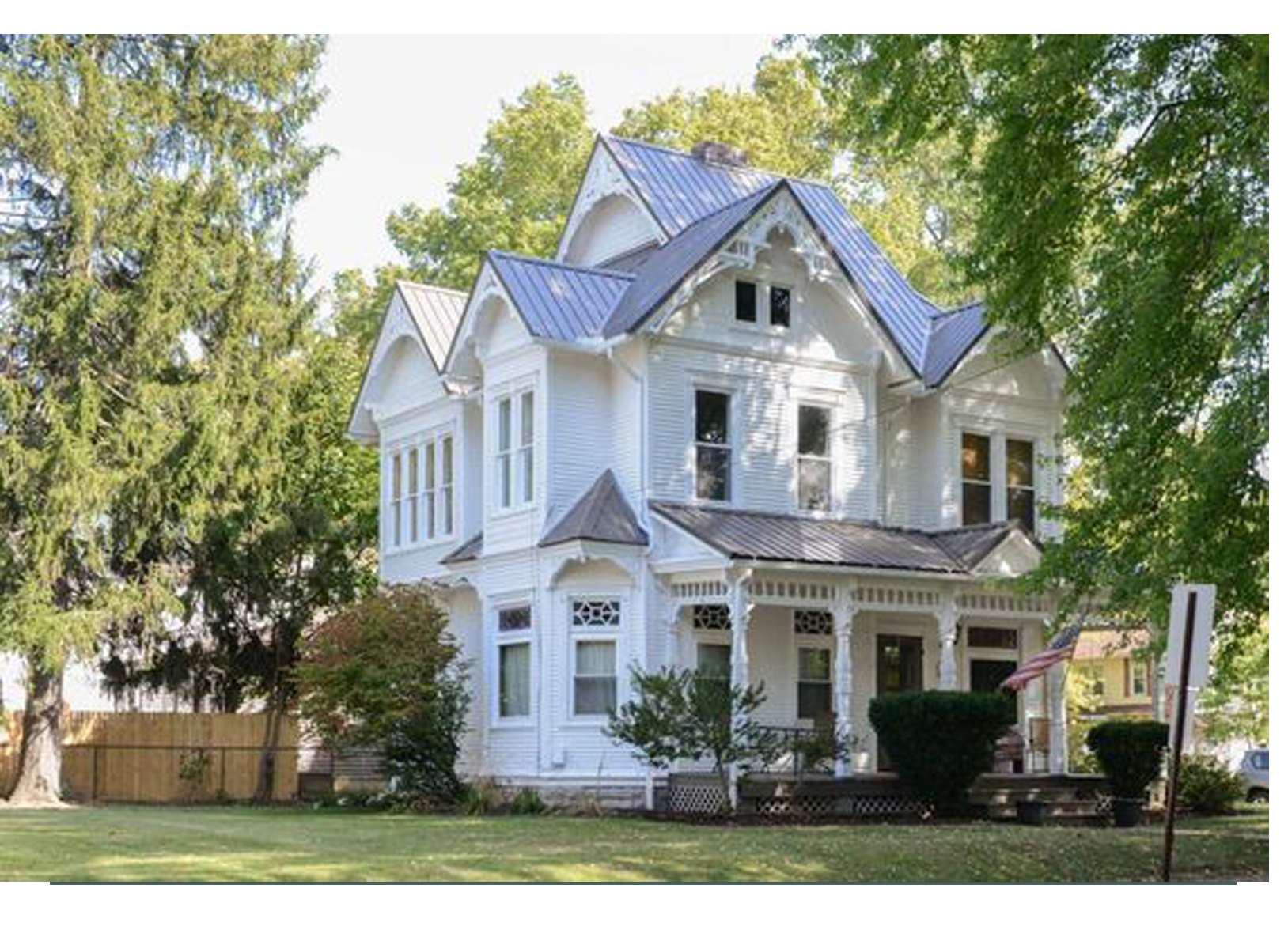
House Hunting
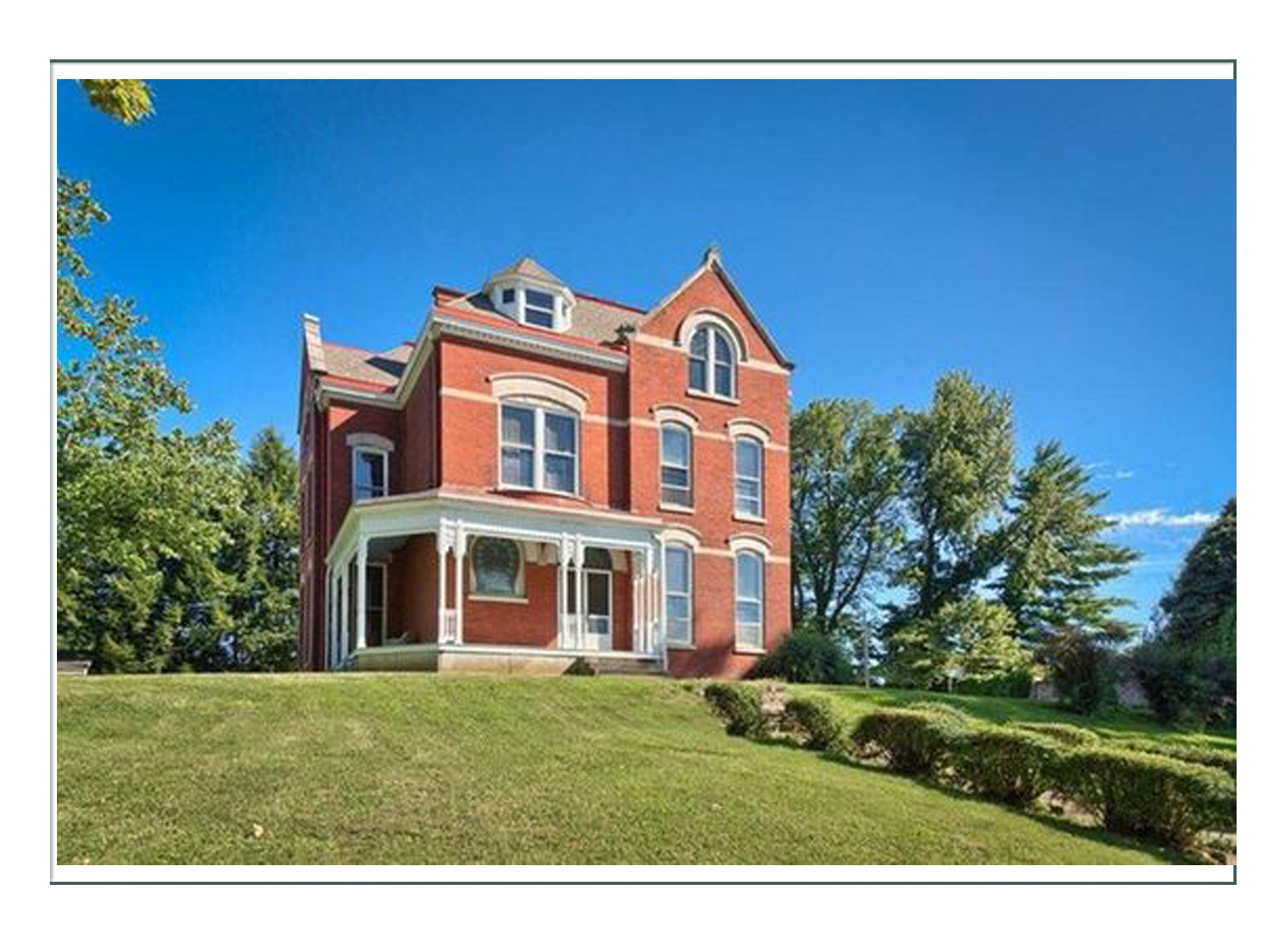

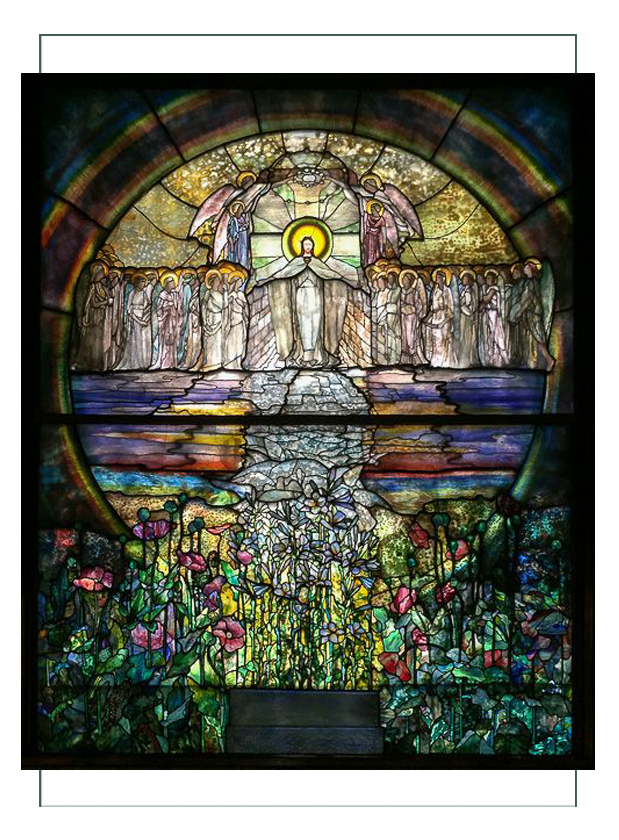
Maudlin becomes Symbolism – Regency turns to Victorian
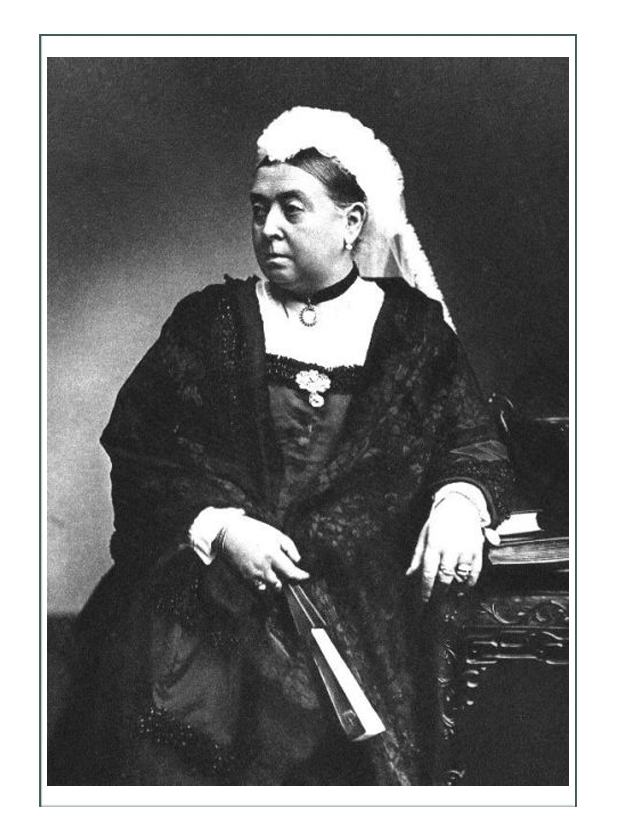
When Prince Albert, Queen Victoria’s husband died December 1861, she wore black from that day until the end of her life, and all society followed. How she handled it, combined with ideas of purgatory and heaven vs hell, set the standards and processes for dealing with ones own death and the death of loved ones.
The late Victorian ideal was to have a “good death”, which was a “lingering death” which gave one preparation for the next world. The elaborate, strict customs that would evolve from this would become expensive, constant, and eternally preying on one’s spiritual well-being as with the current chance of survival of children to adulthood only 50%, and lifespans shortened by continuous wars, epidemics, a newly industrialized and densely populated urban society, a person was almost always in some stage of mourning.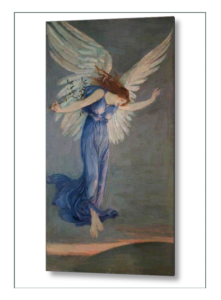
The previous, Regency Era had featured grotesque symbols like skulls and fearful icons and masks, so the Victorian focus on “Memento Mori” (“remember you have to die”) was more a reminder that one should live a life to prepare for the afterlife, and for that of those you loved. This had practical application too, in saving up to pay for the elaborate customs that would continue in full force until a year or two after Victoria’s death in 1901, and many rituals which still continue today.
Victorian Ritual and Practices
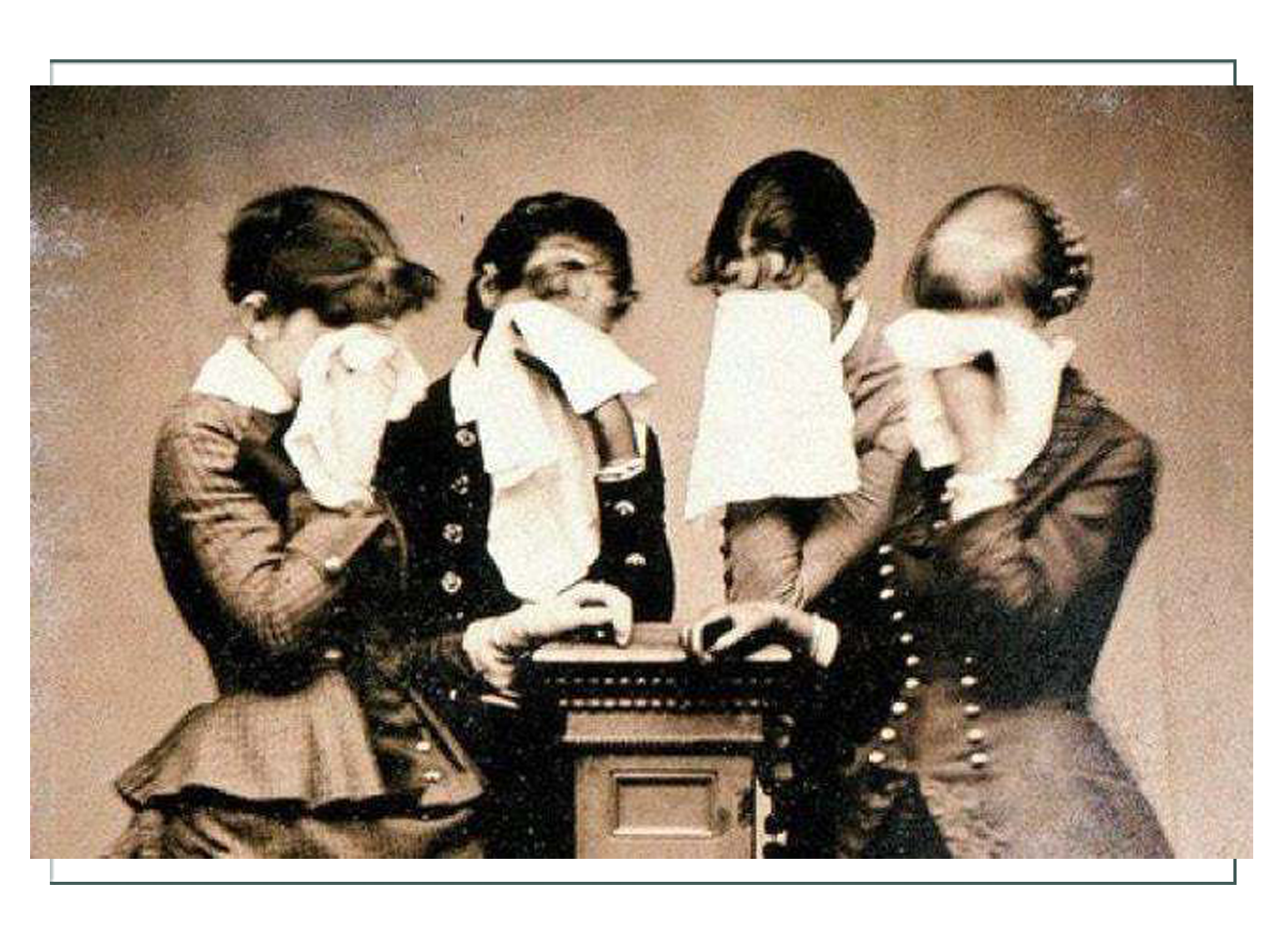
In 1901, there was a quick rise and equally quick wane of cremation and inexpensive, simple burials after the death of the Queen. War and epidemics made everyone much more practical, but they were right back to it for many more years.
Mourning was toughest on women, who had strict rules governing their lives for 2 1/2 years after the death of a loved one. With so many loved ones dieing, a woman at one point would just go into eternal mourning. (Fashion and clothing rules will be continued on Lynette’s Fashion History page next).
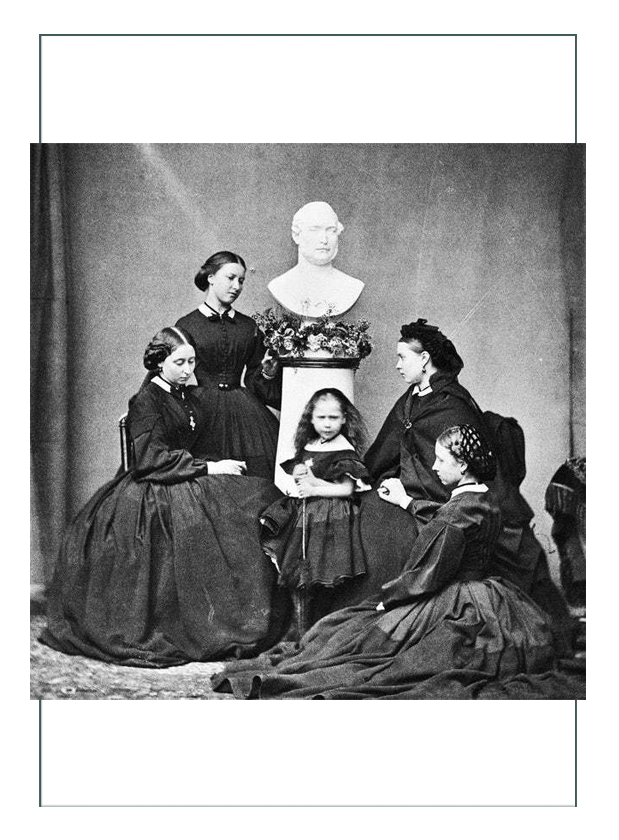
Following are key rituals, traditions, and requirements during the Victorian and early Edwardian eras for mourning:
Mirrors to be covered so souls of the dead are not trapped.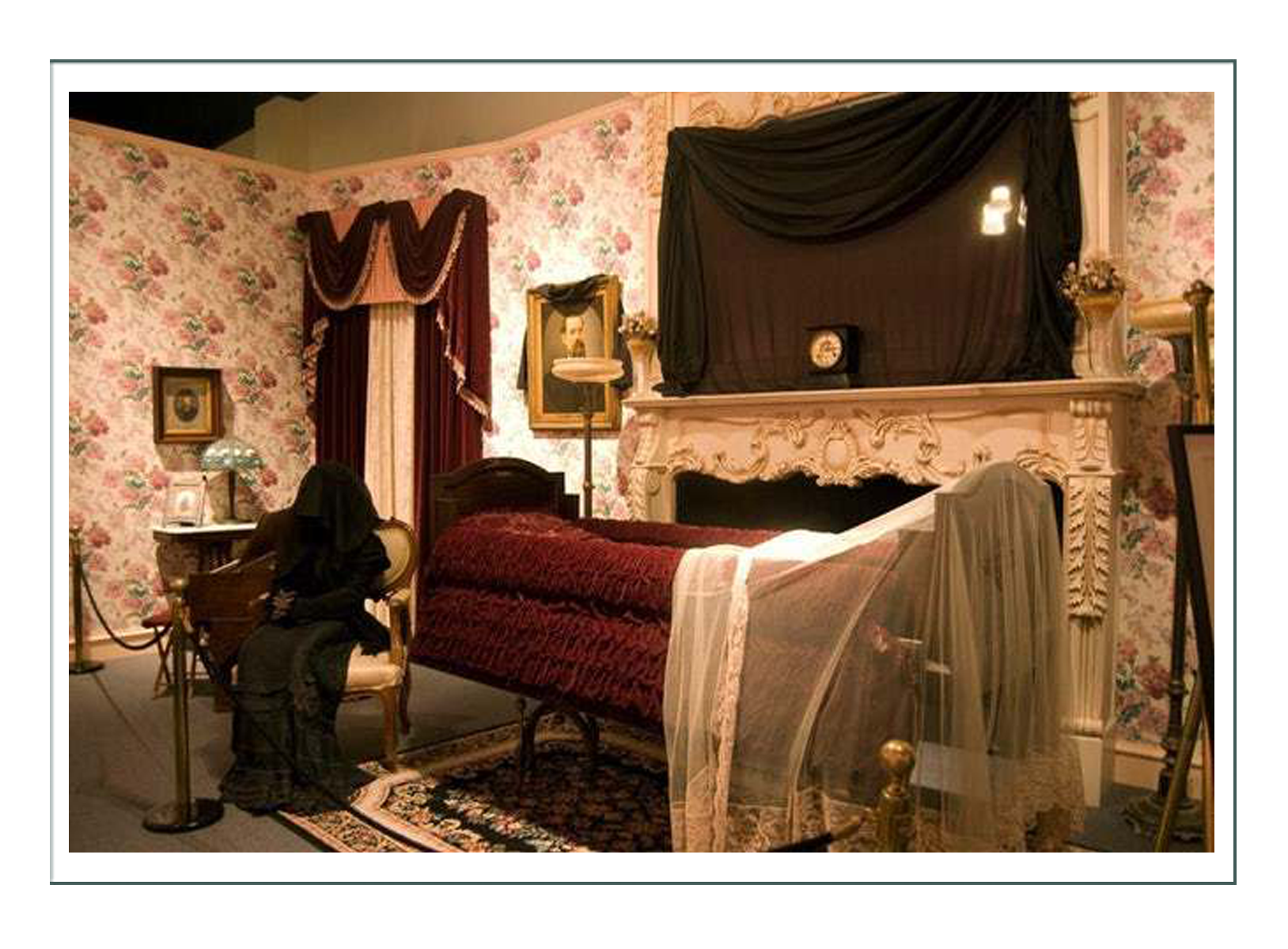 Family portraits to be covered or flipped so the dead spirit does not attempt to possess the living.
Family portraits to be covered or flipped so the dead spirit does not attempt to possess the living.
Special portraits showing their grief were favorites; especially with royalty when the head of household died, and there were many daughters as in the case of Queen Victoria.
Posing with the dead; extensive “Post Mortem” photography and a huge industry were developed where family members, particuarly parents and siblings would pose with their deceased loved one in domestic settings. Photographers had a huge array of stands and braces, and tricks like having the mother hold the dead baby from behind a blanket in their arsenal.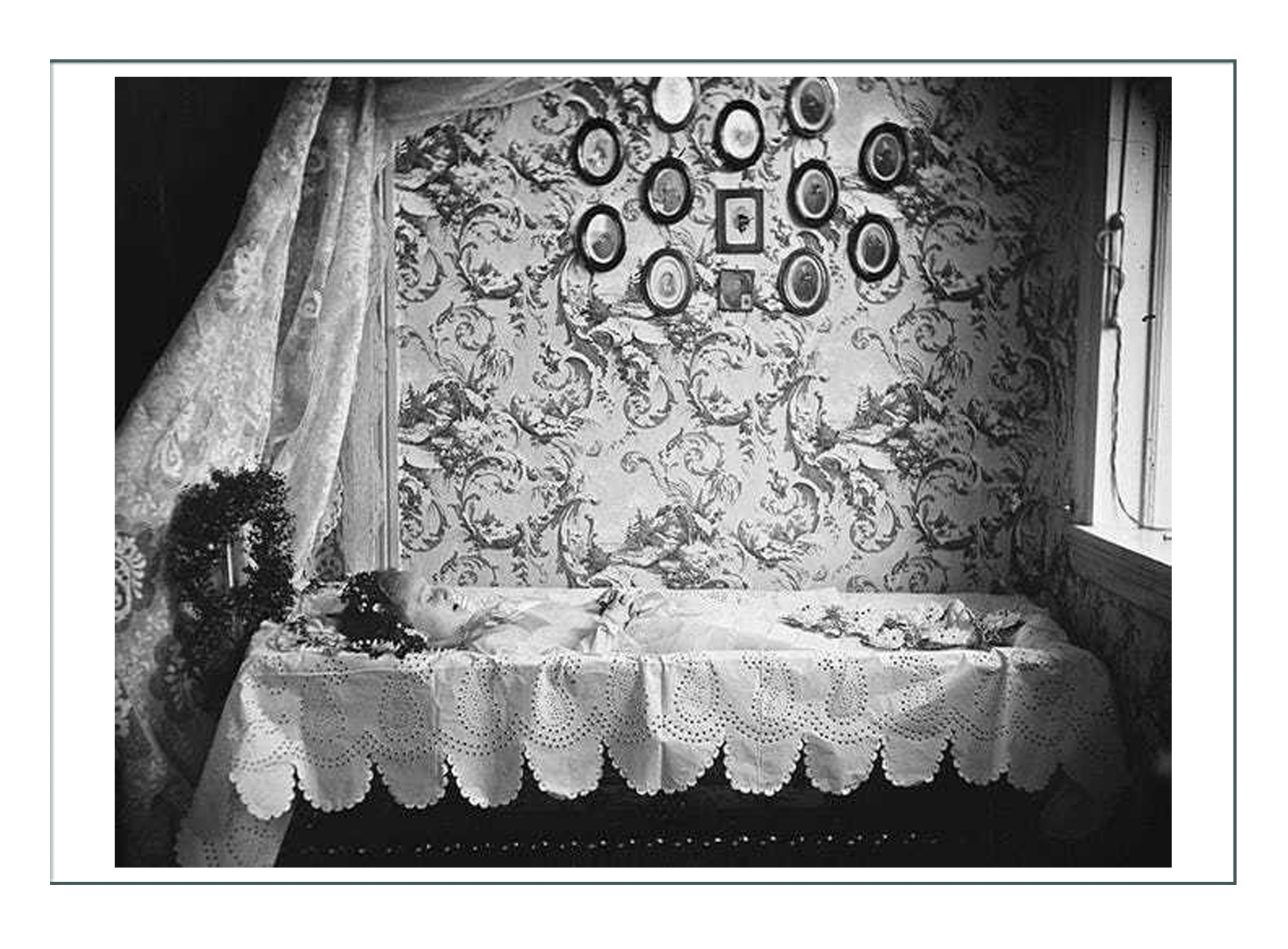
Specific techniques in posing the dead included painting in the eyes over closed eyelids, having the living hold up the dead, and taking pictures of the loved one in their casket.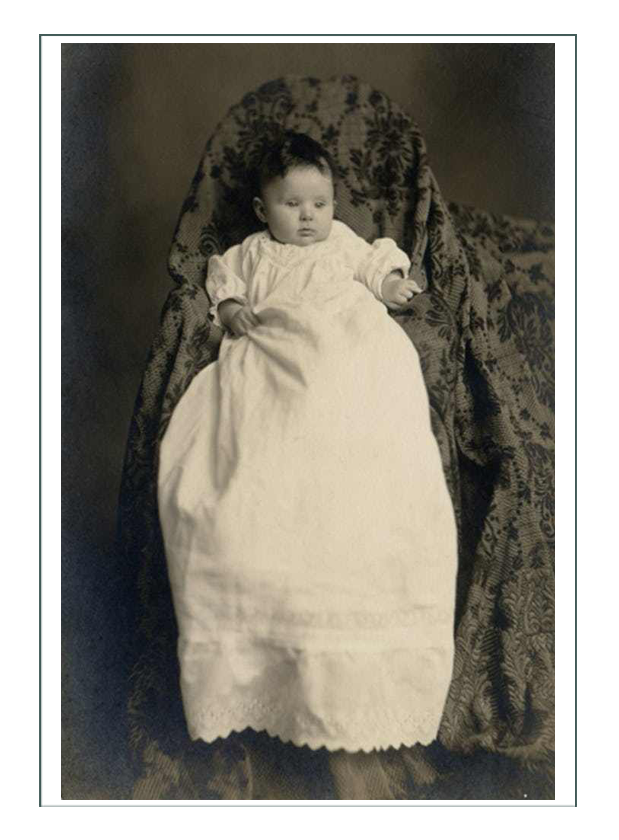
Babies were a favorite for posing and painting the eyes.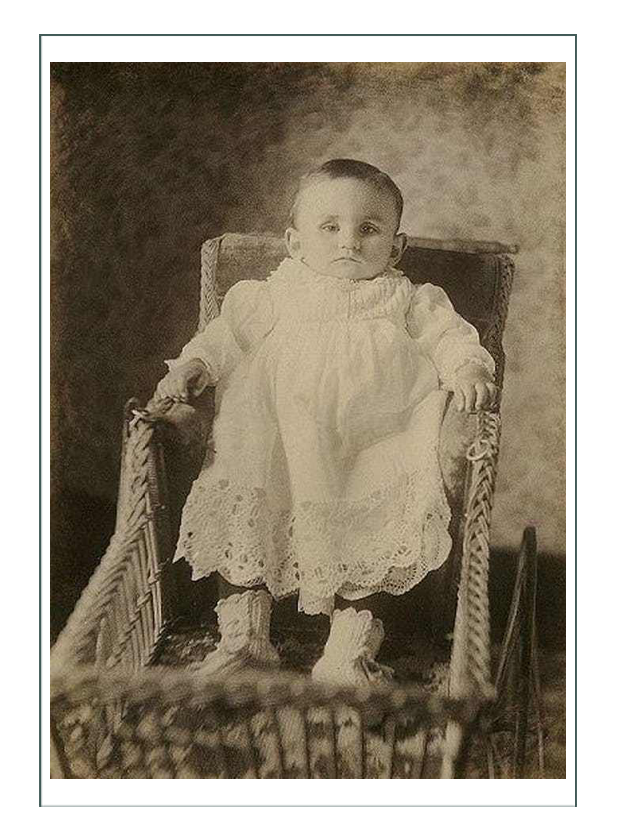 More than one dead person was often in the same photo, and along with live ones. This was very typical in wartime with families, and when multiple siblings died, such as in an epidemic.
More than one dead person was often in the same photo, and along with live ones. This was very typical in wartime with families, and when multiple siblings died, such as in an epidemic.
Lifelike dolls of infants were made of sand and cloth bodies that felt like the real thing. While these were used typically only for ceremonies and left at the gravesite, many parents kept them as mementos.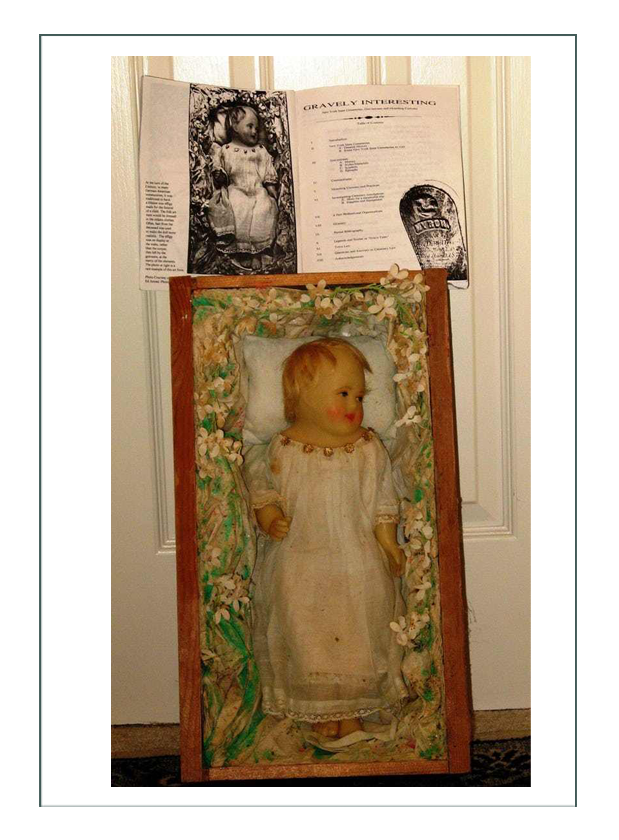
Death kits were available starting in the 1870’s – these would be books and dolls and instructional guides to train young girls how to perform the rituals of mourning
The invention of the “safety coffin” came from scientists because the medical knowledge was still quite limited, and some people had been known to be in comas only from an illness – only to wake upon being buried alive. This was an absorbing fear of many, so coffins were often fitted with a bell and a pull in the deceased’ hand so he/she could ring it above ground should they wake up. One doctor made a window with a long tube to look down in case he came alive. Ironically, he died on Halloween in 1893.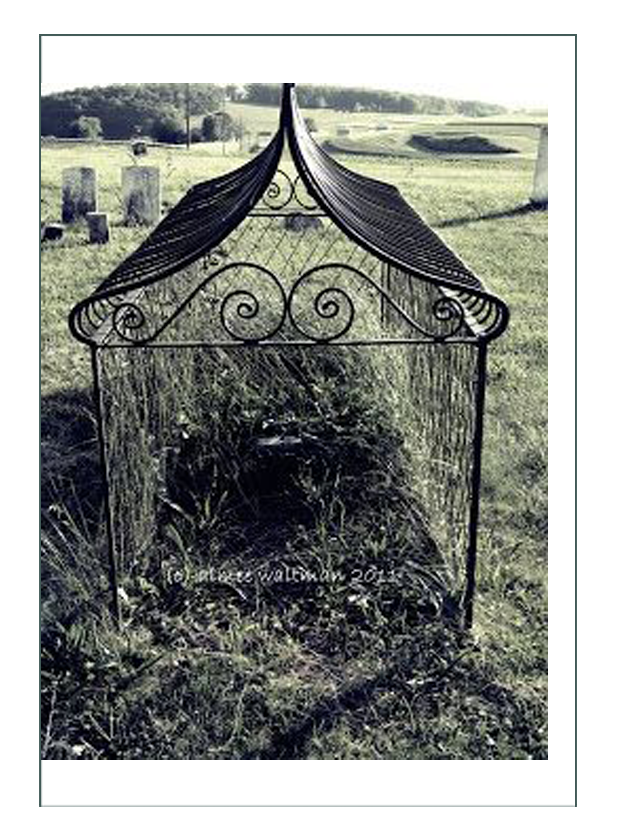
Because science was so short of cadavers for study, grave robbing became a very big business. Graves had to be fortified against “Resurrection Men”, who would get so desperate and paid so well sometimes they would kill to get a corpse. Grave robbers would usually dig tunnels from a few yards away to the head of the coffin so they could pull the body out by the head, and the grave would appear to be unharmed. Their court sentences if caught were lighter if they only had a body, so usually all clothing and anything buried in the coffin was left undisturbed.
Because of grave robbers, wealthy built locked vaults and huge iron fortresses around graves. In cities in particular, full family locked concrete or stone vaults were built for bodies so no one could dig or open the graves. Poor people put flowers and plants around the periphery of the grave, along with freshly dug dirt so that they could see if anything had been disturbed. In the west and pioneer graves in particular, metal fences were used. These kept wild animals at bay for at time too in remote or wooded burial locations.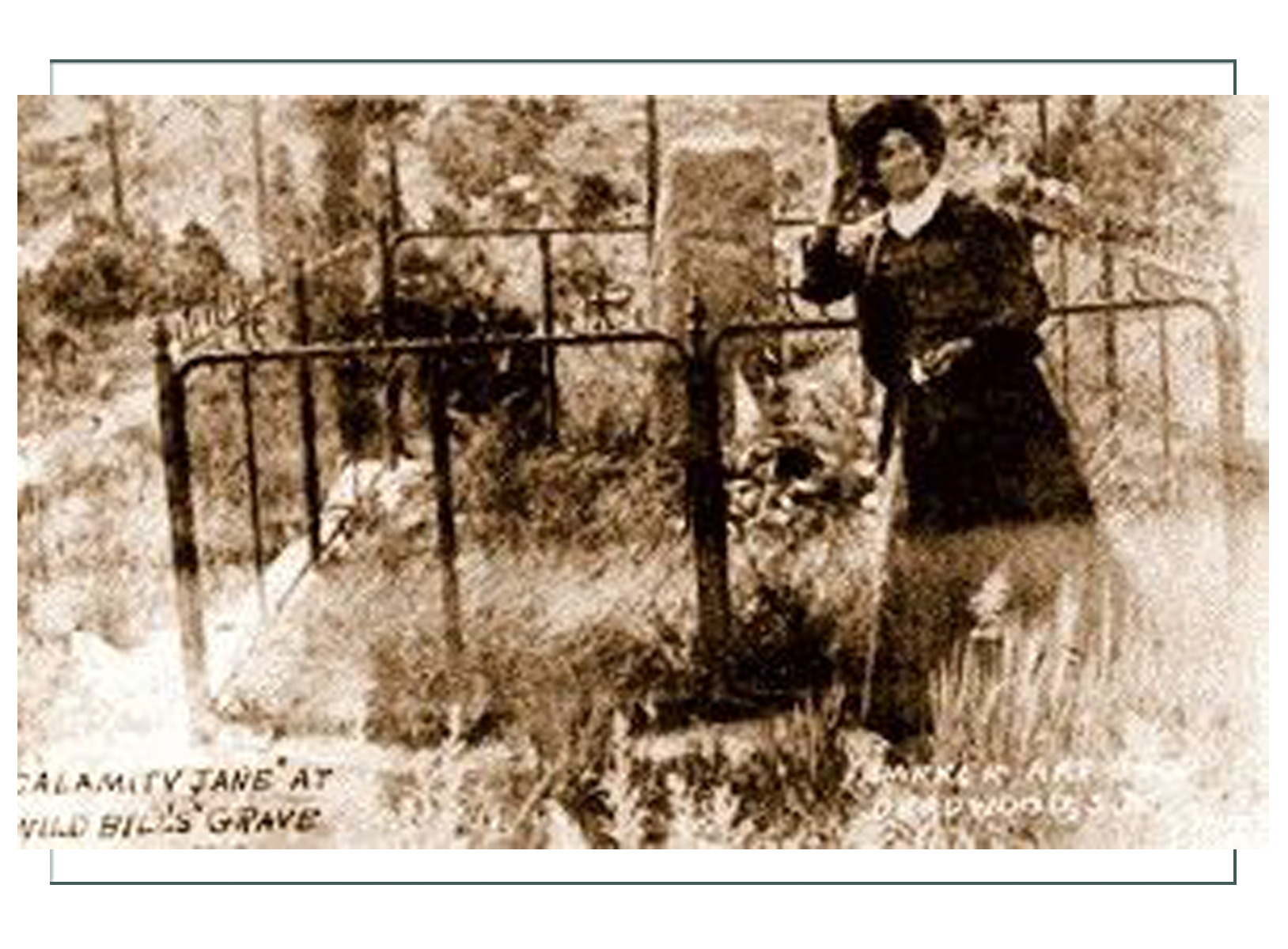
Professional Mourners were hired to “ramp up the grief”, although it was considered socially bad taste to openly cry out or grieve in public. The professionals had to discreetly be emotional from the sidelines or in procession to only the appropriate degree of emotion.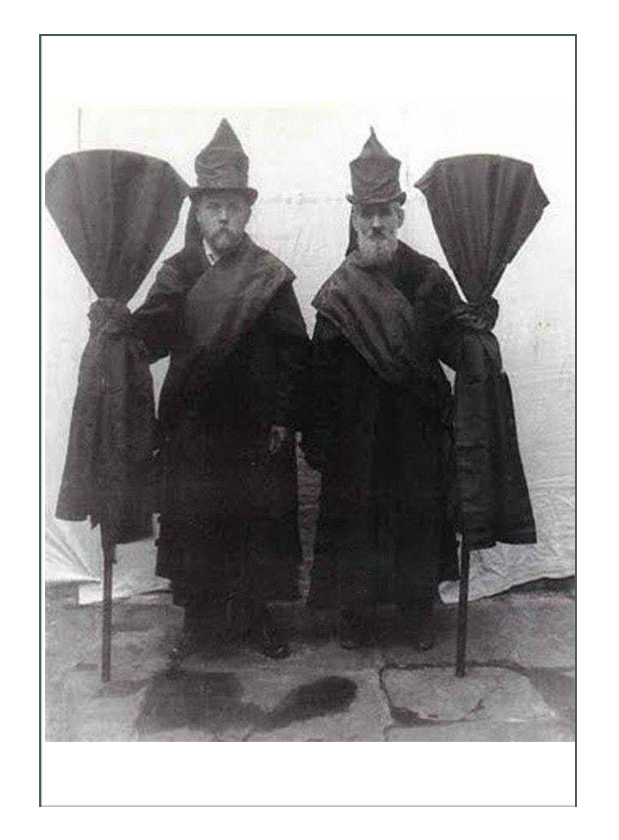
Scrapbooks were kept with photos of the dead for the family to continually enjoy in their parlor.
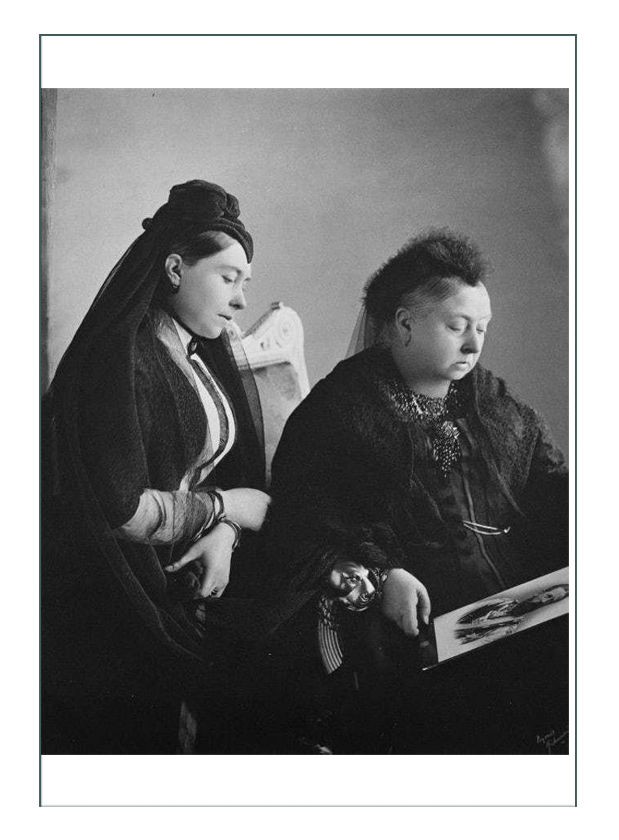
Clocks were stopped at the time of the death.
The body was carried out of the house head first so it wouldn’t call the living to follow it to the grave.
Children had small white hearses pulled by ponies.
Doorknobs were draped with black crape fabric to tell that the dead were within. White crape was used for a single, young woman who died.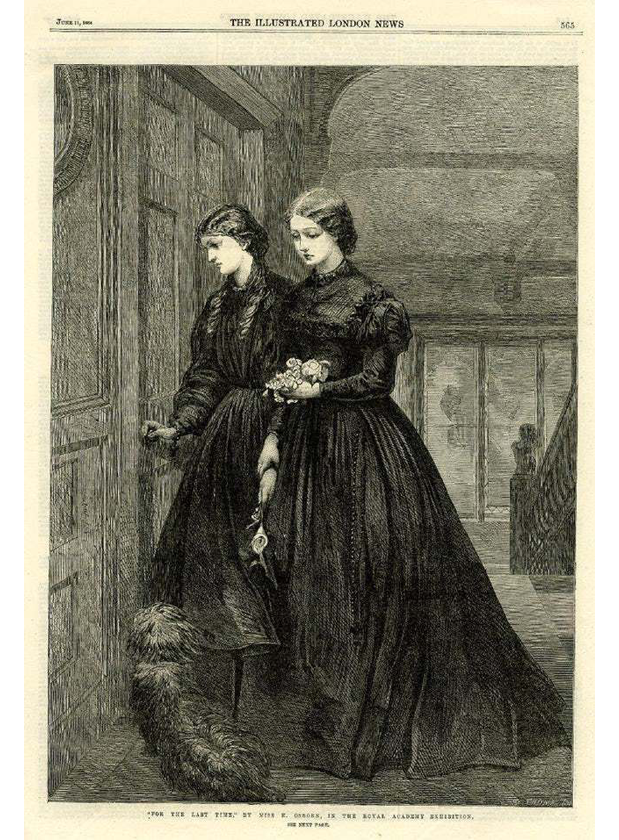
Pets were given elaborate funerals complete with coffins, invitations, and visitations. When a pet owner was being mourned, the pet was required to go into mourning also.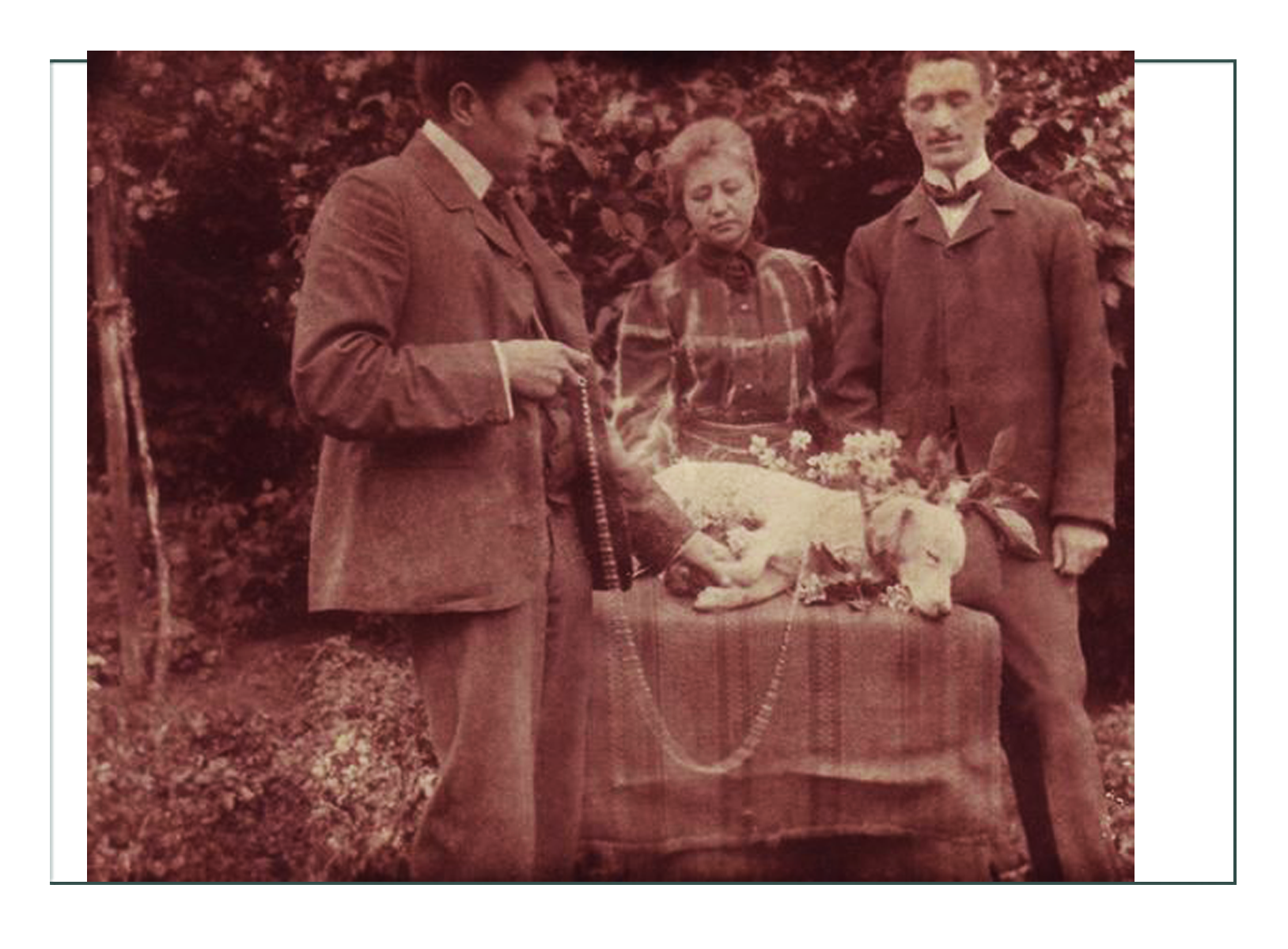
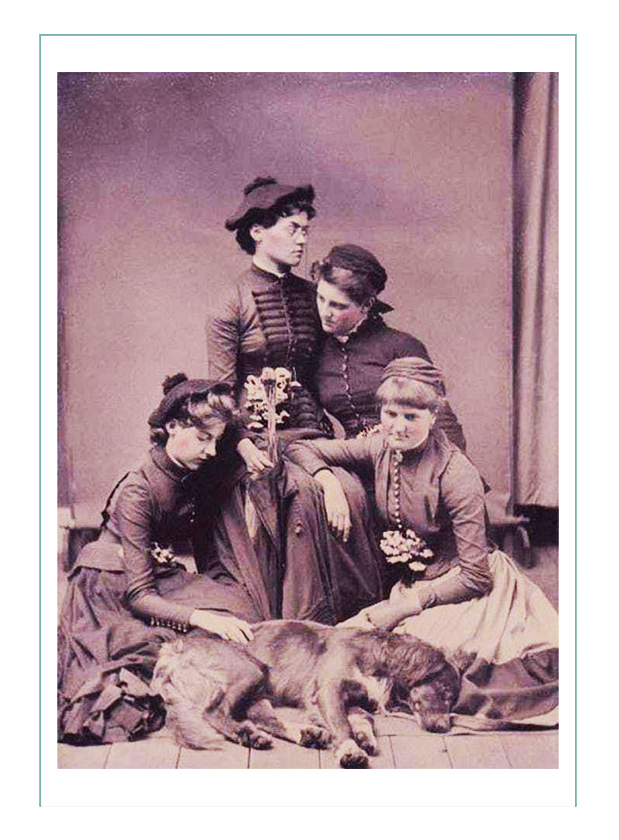
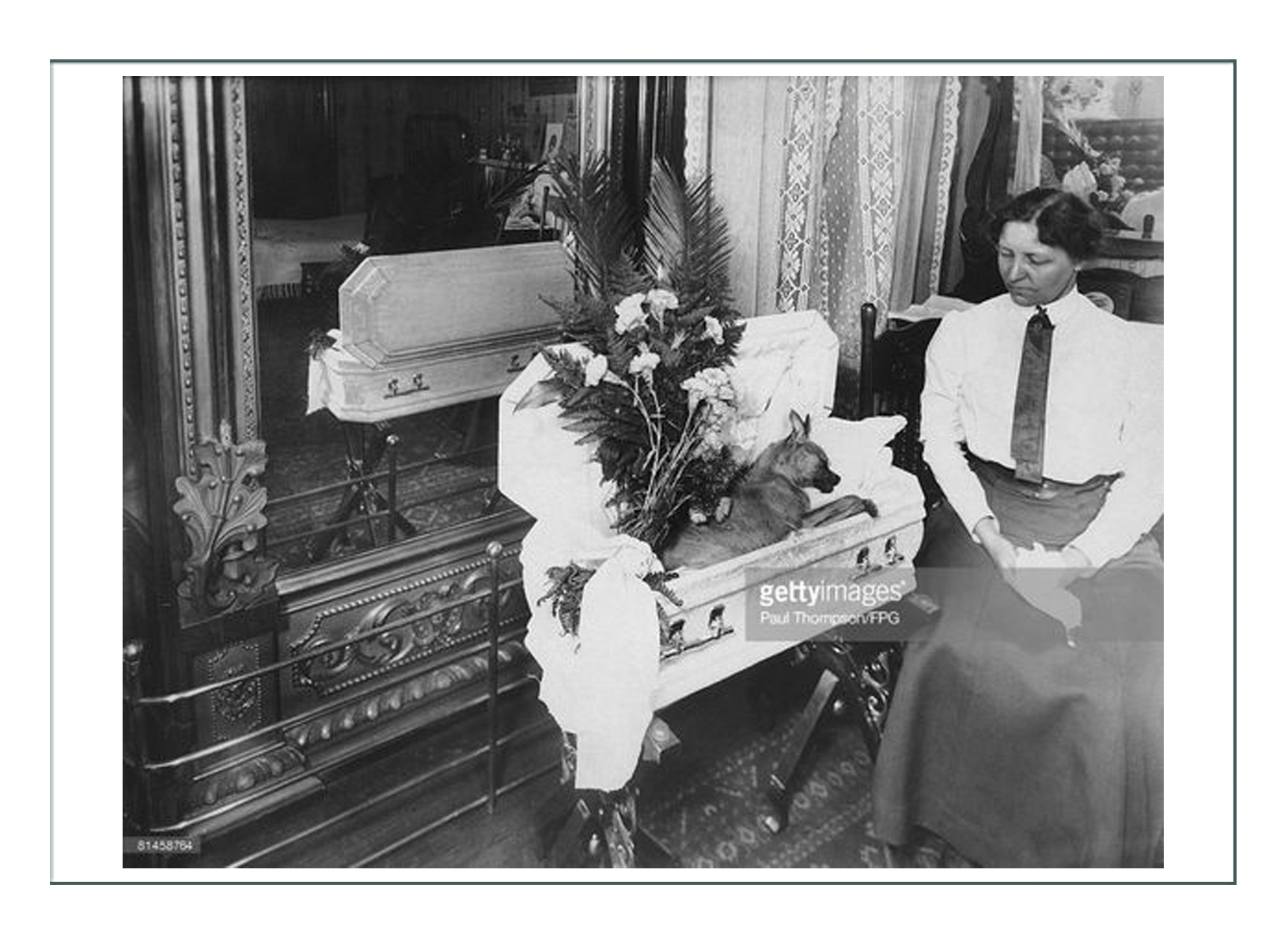
Funerals were a complex production with the whole family and friends involved. They were a BIG public affair with a funeral director, horses, hearses, elaborate floral displays, invitations, pall bearers, photos, special seating. It was the job of the family to watch over the person as they died, and the job of friends to sit by the dead during proceedings.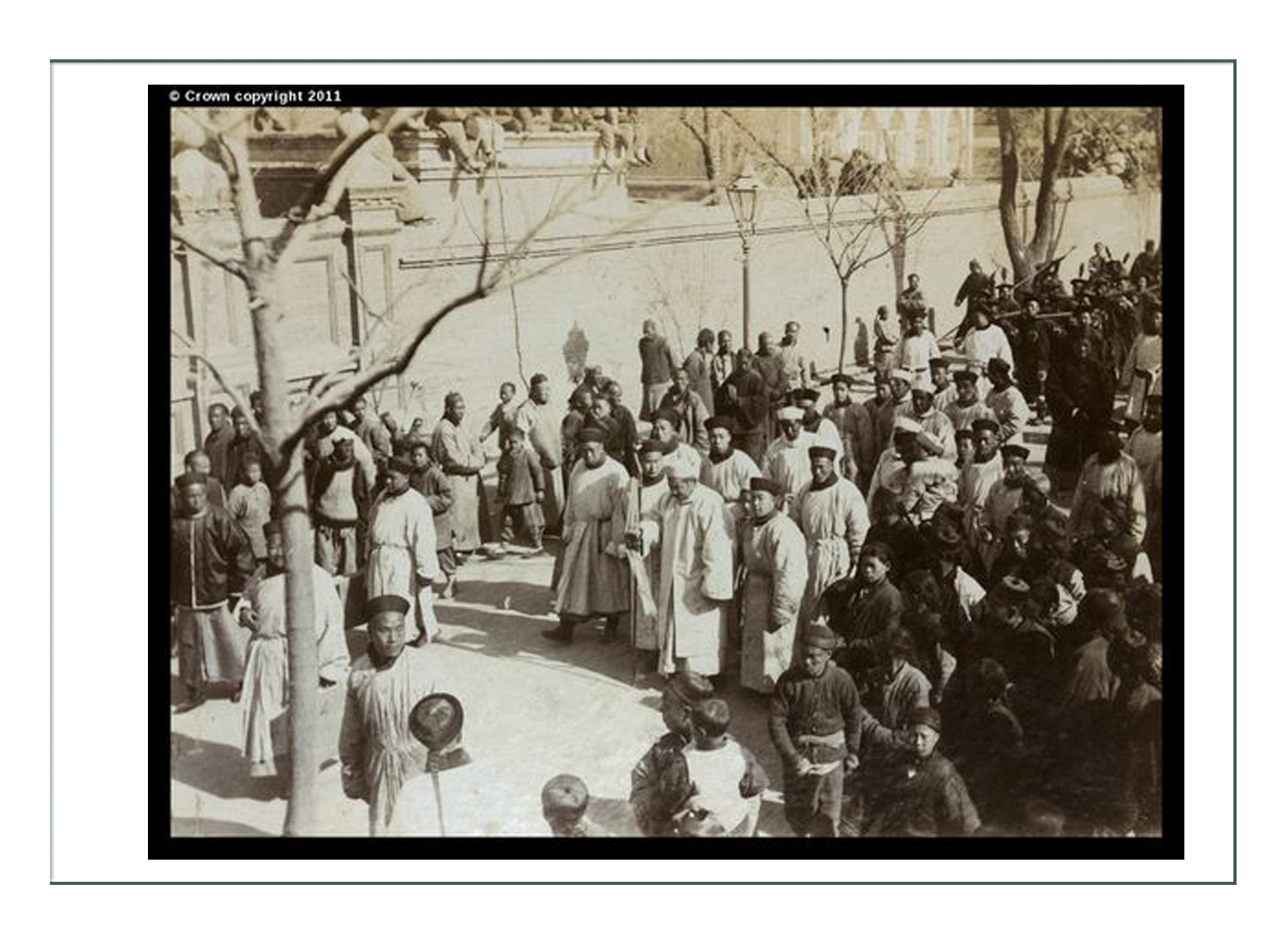
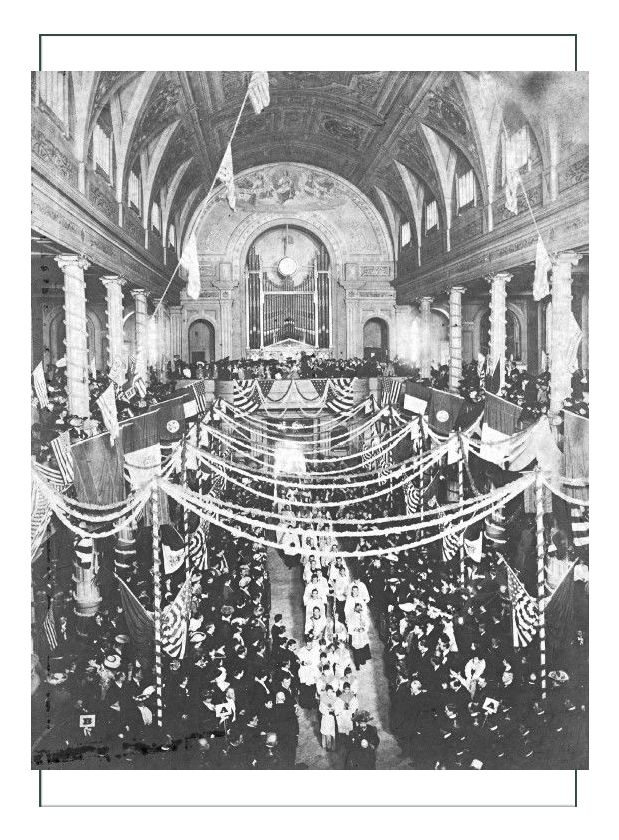
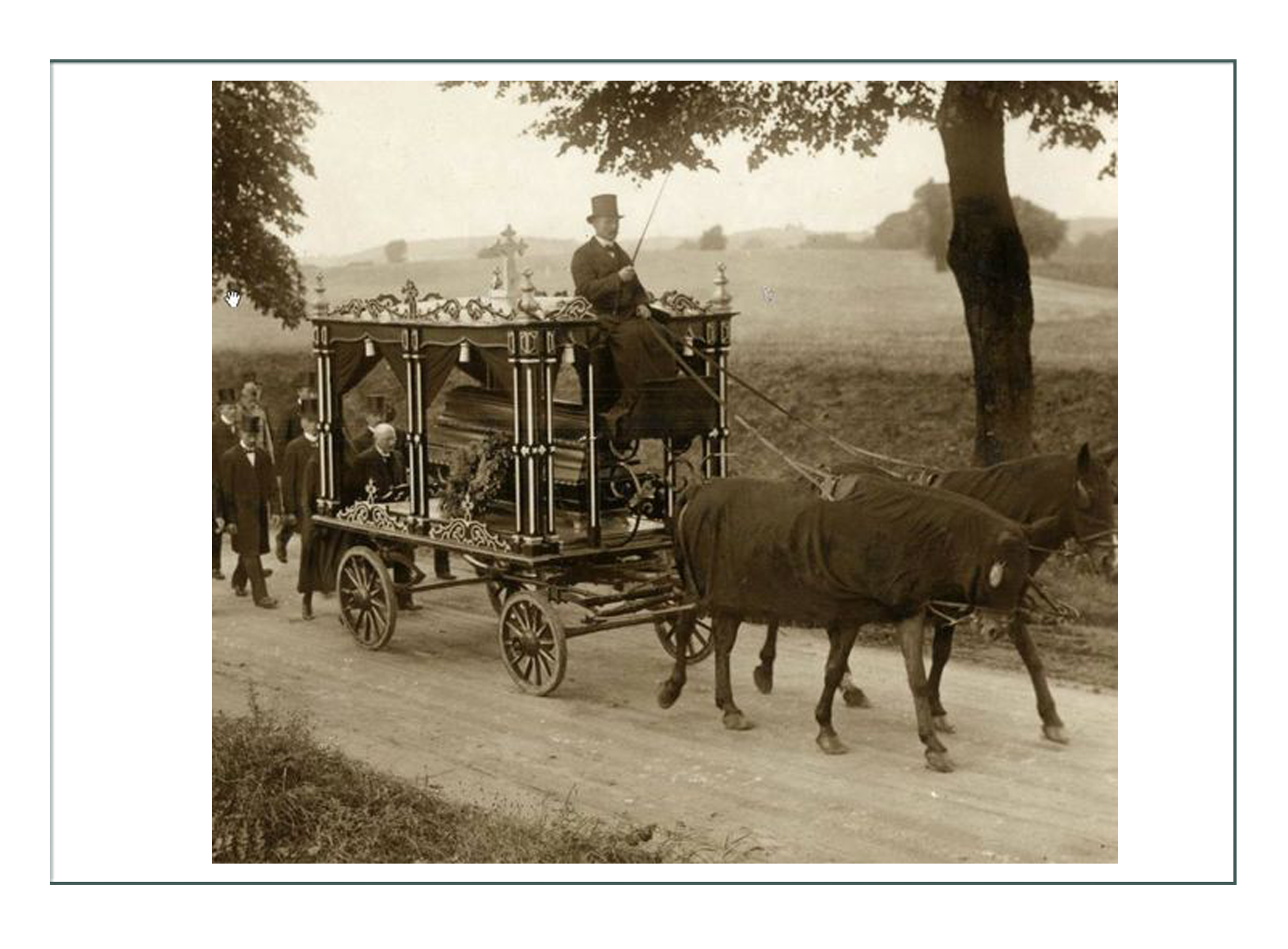
Sometimes if a loved one was ill, a family would not spend money on health care so that they would have enough for the funeral; thus speeding the necessity for a funeral along quickly.
There were “burial clubs” which were like today’s insurance policies that one paid in to during their life in anticipation of their own death. By the mid 1850’s England, there were 50,000 deaths per year, and virtually no room to put all the people, so a “Poor Union” was created which took care of death costs and threw paupers into a common grave. This was considered the lowest of low.
Because parks had not been created yet, and the concept of park or recreational space not been invented, cemeteries were not only the place to bury dead, but to enjoy living. It was very common, especially in cities, for families to spend the day picnicking and playing in a cemetery. It was only later that cemeteries were quiet and respectful places.
Places to Mourn.. or Play
The Fashion of Mourning continued next page (bottom)!
Click here to go to Fashion & Women’s History Page (next)
Click here to to to Design Development Page

